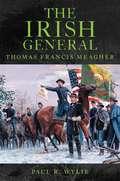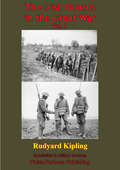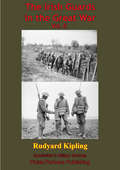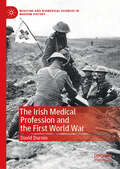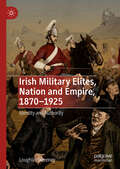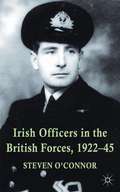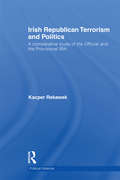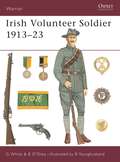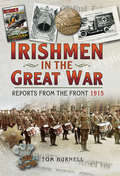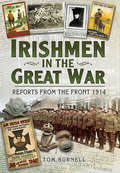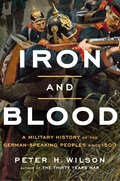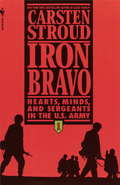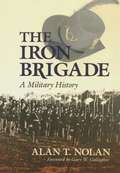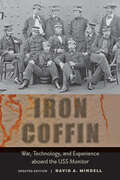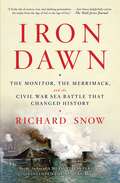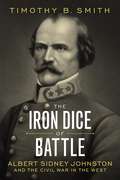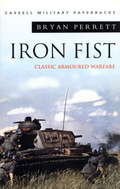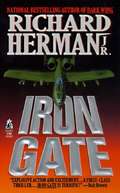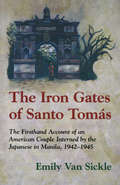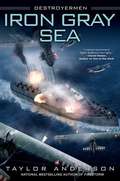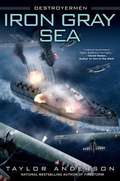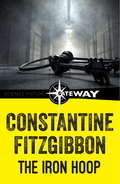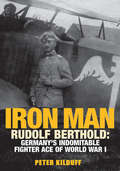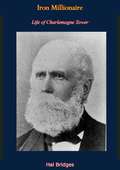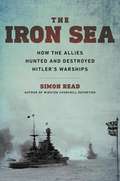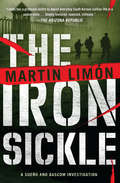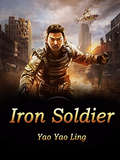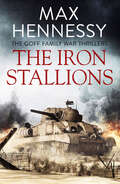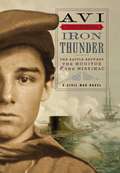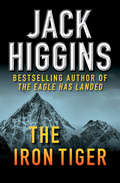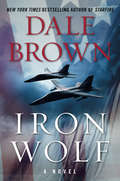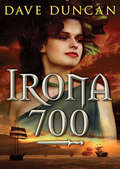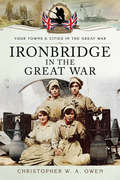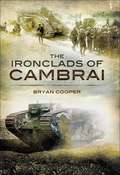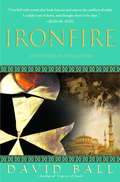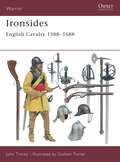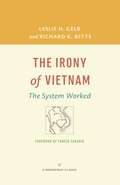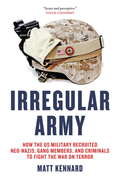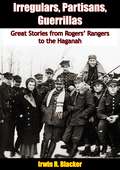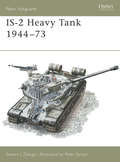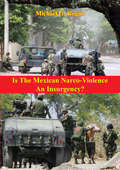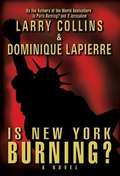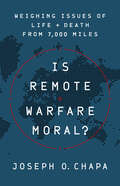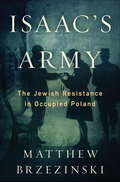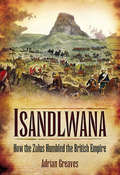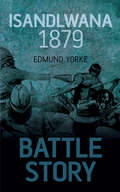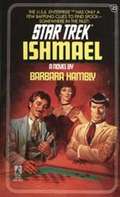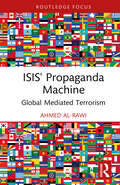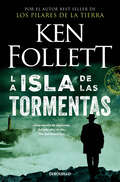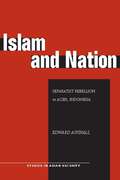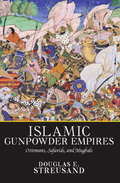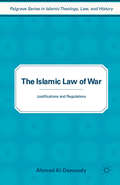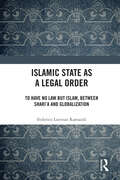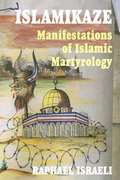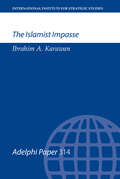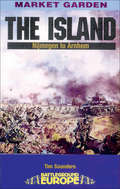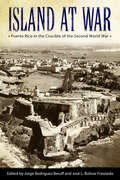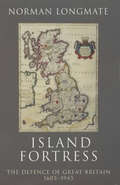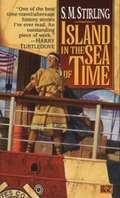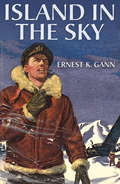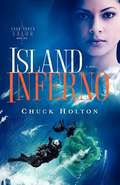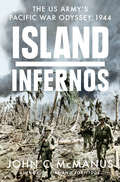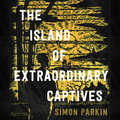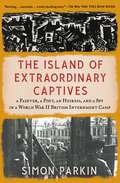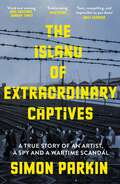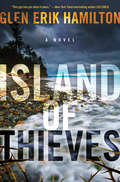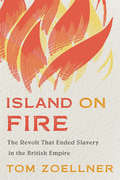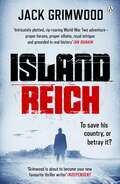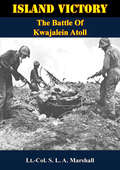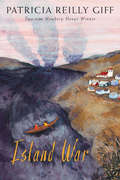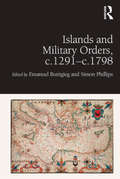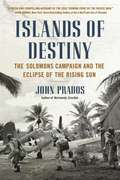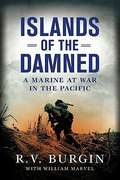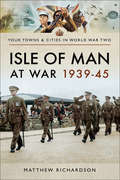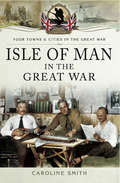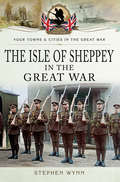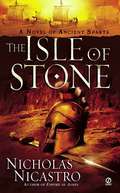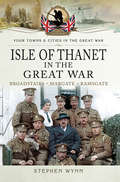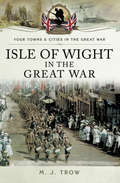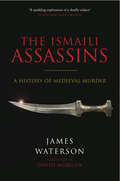- Table View
- List View
The Irish General: Thomas Francis Meagher
by Paul R. WylieIrish patriot, Civil War general, frontier governor--Thomas Francis Meagher played key roles in three major historical arenas. Today he is hailed as a hero by some, condemned as a drunkard by others. Paul R. Wylie now offers a definitive biography of this nineteenth-century figure who has long remained an enigma. The Irish General first recalls Meagher's life from his boyhood and leadership of Young Ireland in the revolution of 1848, to his exile in Tasmania and escape to New York, where he found fame as an orator and as editor of the Irish News. He served in the Civil War--viewing the Union Army as training for a future Irish revolutionary force--and rose to the rank of brigadier general leading the famous Irish Brigade. Wylie traces Meagher's military career in detail through the Seven Days battles, Antietam, Fredericksburg, and Chancellorsville. Wylie then recounts Meagher's final years as acting governor of Montana Territory, sorting historical truth from false claims made against him regarding the militia he formed to combat attacking American Indians, and plumbing the mystery surrounding his death. Even as Meagher is lauded in most Irish histories, his statue in front of Montana's capitol is viewed by some with contempt. The Irish General brings this multi-talented but seriously flawed individual to life, offering a balanced picture of the man and a captivating reading experience.
The Irish Guards In The Great War – Vol. I. [Illustrated Edition]
by Rudyard KiplingA Fantastic Regimental History of an Illustrious regiment, awarded two coveted stars by the renowned military historian and Times War Correspondent Cyril Falls:"One could be assured that when Mr Kipling turned his hand to a regimental history the result would be very different to the ordinary. The particular invention wherewith he has enriched this book is a sort of chorus--the comment of the private soldier upon the events narrated, which is witty and effective. Mr Kipling has also brought to bear his magic upon that most matter-of-fact of records, the battalion war diary, and has made it live. *** he has composed a noble tribute to the great regiment in the ranks of which he lost his son."-- Cyril Falls, War Books, London 1930.Illustrated with sumptuously detailed maps.
The Irish Guards In The Great War – Vol. II. [Illustrated Edition]
by Rudyard KiplingA Fantastic Regimental History of an Illustrious regiment, awarded two coveted stars by the renowned military historian and Times War Correspondent Cyril Falls:"One could be assured that when Mr Kipling turned his hand to a regimental history the result would be very different to the ordinary. The particular invention wherewith he has enriched this book is a sort of chorus--the comment of the private soldier upon the events narrated, which is witty and effective. Mr Kipling has also brought to bear his magic upon that most matter-of-fact of records, the battalion war diary, and has made it live. *** he has composed a noble tribute to the great regiment in the ranks of which he lost his son."-- Cyril Falls, War Books, London 1930.Illustrated with sumptuously detailed maps.
The Irish Medical Profession and the First World War (Medicine and Biomedical Sciences in Modern History)
by David DurninThis book examines the role of the Irish medical profession in the First World War. It assesses the extent of its involvement in the conflict while also interrogating the effect of global war on the development of Ireland’s domestic medical infrastructure, especially its hospital network. The study explores the factors that encouraged Ireland’s medical personnel to join the British Army medical services and uncovers how Irish hospital governors, in the face of increasing staff shortages and economic inflation, ensured that Ireland’s voluntary hospital network survived the war. It also considers how Ireland’s wartime doctors reintegrated into an Irish society that had experienced a profound shift in political opinion towards their involvement in the conflict and subsequently became embroiled in its own Civil War. In doing so, this book provides the first comprehensive study of the effect of the First World War on the medical profession in Ireland.
Irish Military Elites, Nation and Empire, 1870–1925: Identity and Authority
by Loughlin SweeneyThis book is a social history of Irish officers in the British army in the final half-century of Crown rule in Ireland. Drawing on the accounts of hundreds of officers, it charts the role of military elites in Irish society, and the building tensions between their dual identities as imperial officers and Irishmen, through land agitation, the home rule struggle, the First World War, the War of Independence, and the partition of Ireland. What emerges is an account of the deeply interwoven connections between Ireland and the British army, casting officers as social elites who played a pivotal role in Irish society, and examining the curious continuities of this connection even when officers’ moral authority was shattered by war, revolution, independence, and a divided nation.
Irish Officers in the British Forces, 1922–45
by Steven O’ConnorIrish Officers in the British forces, 1922-45 looks at the reasons why young Irish people took the king's commission, including the family tradition, the school influence and the employment motive. It explores their subsequent experiences in the forces and the responses in independent Ireland to the continuation of this British military connection.
Irish Republican Terrorism and Politics: A Comparative Study of the Official and the Provisional IRA (Political Violence)
by Kacper RekawekThis book examines the post-ceasefire evolutions and histories of the main Irish republican terrorist factions, and the interconnected character of politics and militarism within them. Offering the first comparative study of the two leading Irish republican terrorist movements the Official IRA and the Provisional IRA (PIRA), this book presents the lesser-known Officials’ political-military evolution and analyses whether they could have been role models for the Provisionals. Not only does it compare the terrorism and the politics of the Officials and Provisionals in the aftermath of their seminal ceasefires of 1972 and 1994, it also presents the Irish republican history in a new light and brings to the fore the understudied and disregarded Officials who called their seminal ceasefire twenty-two years before their rivals in 1972. In doing this, the work discusses whether the PIRA might have learned lessons from the bitter and ultimately unsuccessful experience of the Officials. This book goes beyond traditional interpretations of the rivalry and competition between the two factions with the Officials usually seen as non-violent but unsuccessful and the Provisionals less politically inclined and mostly concerned with their armed struggle. Simultaneously, it dispels the myth of the alleged Provisional republican copying of their Official republican counterparts who seemed ready for a political compromise in Northern Ireland more than twenty years before the Good Friday Agreement of 1998. Finally, it comprehensively compares the Officials and the Provisionals within the identified key areas and assesses the two factions’ differences and similarities. . This book will be of much interest to students of Irish politics, terrorism studies, security studies and politics in general.
Irish Volunteer Soldier 1913-23
by Gerry White Bill YounghusbandThe political situation in Ireland at the beginning of the 20th century was characterised by crisis and change. Armed rebellion against the British Crown, the prosecution of the Anglo-Irish War, the emergence of the Irish Free State, and the eruption of the Civil War over the treaty with Great Britain ensured that the birth of the modern Irish nation was bloody and difficult. This book details the life of an average Volunteer, and includes the experiences of internment, the lack of established medical facilities for wounded, life on the run, discipline, and typical duties.
Irishmen in the Great War: Reports From The Front 1915
by Tom BurnellIn a quest to to discover the forgotten Irishmen in twenty-seven Irish newspapers, many of which are now obsolete, the author uncovered unbelievable and forgotten newspaper articles, cast aside since the 1920s until now. Following the success of the first book in the series covering 1914, Irishmen in the Great War: Reports from the Front 1915 is a labour of love from author Tom Burnell, containing over 150 hand-picked news stories taken from a selection of twenty-seven Irish newspapers throughout the course of the year. These rare and untapped stories, many of which have not seen the light of day since the 1920s, give a unique insight into life on the front line and on the home front during the First World War.These are the accounts of local men at the front, letters sent home from soldiers in the trenches at Flanders, graphic narratives from allied gun turrets, Irish nuns at Ypres, Irish POWs held in Germany, troops coming under fire on Christmas morning and many more.We are presented with articles explaining the logistical side of supporting the army, from how the men at the front were fed to combating ailments brought about by living in the trenches. A letter from a surgeon of the King's Country Infirmary explains the graphic experiences of everyday life on the front line and the newspapers present feature articles on the use of torpedos, hand grenades, warplanes and more.Translated German letters pay tribute to the courage, stamina and shooting skill shown by the British and letters from British troops remark on the deathly accuracy of the German snipers. We also hear of a Kilkennyman who survived the sinking of the Lusitania and how the attack strengthened the resolve of Irish soldiers on the front.We see letters from lieutenants in the Leinsters, privates in the Munsters at Egypt, the Connaughts at Turkey, a fifteen-year-old soldier of the 18th London Irish Rifles, a Kilmoganny soldier writing to the Kilkenny People during a lull in the fighting, letters explaining how the 2nd Royal Irish Rifles fought at Neuve Chapelle and an officer's harrowing description of a gas attack at Hill 60.Following the success of the first book in the series covering 1914, Irishmen in the Great War: Reports from the Front 1915 is a labour of love from author Tom Burnell, containing over 150 hand-picked news stories taken from a selection of twenty-seven Irish newspapers throughout the course of the year. These rare and untapped stories, many of which have not seen the light of day since the 1920s, give a unique insight into life on the front line and on the home front during the First World War.
Irishmen in the Great War: Reports from the Front 1914
by Tom BurnellTwenty-seven Irish newspapers for the period covering the Great War have been trawled through to deliver the amazing stories of those years which changed the world for ever. These are the accounts of local men at the front; of torpedoed ships; drunken wives; final letters and requests from the trenches. Also eye-witness accounts of the slaughter as it was happening; battle reports from officers serving in Irish regiments; quirky snippets; chaplains' sympathetic letters; P.o.W reports of conditions and war poetry. Here are the tales of the Leinster's, Munster's, Connaught's and Dublin Fusiliers serving in the Ulster Division, 10th and 16th Irish Divisions. We read of medical breakthroughs, paranormal occurrences and miraculous escapes from death. After the Irish Rebellion of April, 1916, these type of articles and casualty lists dwindled to very few as Irish hearts became divided.As featured on Tipp FM and in the Tipperary Star and Dungarvan Observer.
Irma's Story: American by Birth, Hispanic by Choice (Irma's Story Ser.)
by Peter B. Gawenda“The compelling true story of the impassioned love shared between a south Texas woman of Hispanic descent and a German military officer.” —Yvonne Freeman, PhD, professor, Department of Language, Literacy, and Intercultural Studies at the University of Texas at BrownsvilleAfter World War II, Peter, a handsome German pilot, met Irma, a beautiful Texan woman of Hispanic descent. It was love at first sight. Their meeting had been prophesized—for Irma by her grandmother and for Peter by a palm reader—and together the couple would create an extraordinary life. Irma’s Story: American by Birth, Hispanic by Choice chronicles Irma’s life and the experiences of the “Texan Gawendas” during their tenure in the German military in Europe and the United States. Though Irma, accepted as an American while in Europe, faced discrimination in her home country and contended with the challenges of being a military wife, Peter’s love and companionship remained constant.In his second book, Peter B. Gawenda, author of The Children’s War, offers readers an insider’s view of the joys that the marriage of two people—from two completely different worlds—can bring. Presenting the dynamics of racial issues against the backdrop of military life, the captivating story of Irma Lozano de Gawenda depicts a fearless, fiercely loyal woman willing to do anything for her family.Written with a passion that has spanned five decades, Irma’s Story celebrates the strength of a once-in-a-lifetime love.“He thrills [readers] again, turning to his narrative gifts and rich trove of memories to tell another story with universal appeal—the power of enduring love.” —Robert Becker, veteran journalist and former international wire news editor, Houston Chronicle
Iron and Blood: A Military History of the German-Speaking Peoples since 1500
by Peter H. WilsonFrom the author of the acclaimed The Thirty Years War and Heart of Europe, a masterful, landmark reappraisal of German military history, and of the preconceptions about German militarism since before the rise of Prussia and the world wars.German military history is typically viewed as an inexorable march to the rise of Prussia and the two world wars, the road paved by militarism and the result a specifically German way of war. Peter Wilson challenges this narrative. Looking beyond Prussia to German-speaking Europe across the last five centuries, Wilson finds little unique or preordained in German militarism or warfighting.Iron and Blood takes as its starting point the consolidation of the Holy Roman Empire, which created new mechanisms for raising troops but also for resolving disputes diplomatically. Both the empire and the Swiss Confederation were largely defensive in orientation, while German participation in foreign wars was most often in partnership with allies. The primary aggressor in Central Europe was not Prussia but the Austrian Habsburg monarchy, yet Austria’s strength owed much to its ability to secure allies. Prussia, meanwhile, invested in militarization but maintained a part-time army well into the nineteenth century. Alongside Switzerland, which relied on traditional militia, both states exemplify the longstanding civilian element within German military power.Only after Prussia’s unexpected victory over France in 1871 did Germans and outsiders come to believe in a German gift for warfare—a special capacity for high-speed, high-intensity combat that could overcome numerical disadvantage. It took two world wars to expose the fallacy of German military genius. Yet even today, Wilson argues, Germany’s strategic position is misunderstood. The country now seen as a bastion of peace spends heavily on defense in comparison to its peers and is deeply invested in less kinetic contemporary forms of coercive power.
Iron Bravo
by Carsten StroudFirst Sergeant Dee Crane, a Vietnam Eleven Bravo, recounts his experiences alongside his men, his duties at the National Training Center in the Mojave Desert, and his most recent encounters in the Persian Gulf.
The Iron Brigade: A Military History
by Alan T. NolanThis is the story of the most famous unit in the Union Army, the only all-Western brigade in the Eastern armies of the Union―made up of troops from Indiana, Wisconsin, and Michigan.
Iron Coffin: War, Technology, and Experience aboard the USS Monitor (Johns Hopkins Introductory Studies in the History of Technology)
by David A. MindellThe USS Monitor famously battled the CSS Virginia (the armored and refitted USS Merrimack) at Hampton Roads in March 1862. This updated edition of David A. Mindell's classic account of the ironclad warships and the human dimension of modern warfare commemorates the 150th anniversary of this historic encounter.Mindell explores how mariners—fighting "blindly," below the waterline—lived in and coped with the metal monster they called the "iron coffin." He investigates how the ironclad technology, new to war in the nineteenth century, changed not only the tools but also the experience of combat and anticipated today’s world of mechanized, pushbutton warfare. The writings of William Frederick Keeler, the ship’s paymaster, inform much of this book, as do the experiences of everyman sailor George Geer, who held Keeler in some contempt. Mindell uses their compelling stories, and those of other shipmates, to recreate the thrills and dangers of living and fighting aboard this superweapon. Recently, pieces of the Monitor wreck have been raised from their watery grave, and with them, information about the ship continues to be discovered. A new epilogue describes the recovery of the Monitor turret and its display at the USS Monitor Museum in Newport News, Virginia.This sensitive and enthralling history of the USS Monitor ensures that this fateful ship, and the men who served on it, will be remembered for generations to come.
Iron Coffins: A Personal Account of the German U-Boat Battles of World War II
by Herbert A. WernerFrom the Foreword by Captain Edward L. Beach, U.S. Navy (Ret.) "Madness!" cries Werner, and it was madness. But there were heroes, too, who deserve admiration even though their cause was wrong.... No one can fault the warrior who believes in his country so strongly that he dies for it.... Because their leaders told them so, they believed that if they fought desperately, they might save their country from the disaster plainly grinding in from every side. They expected death, and most of them found it, but they fought hard all the same, and they carpeted the ocean floor with their bodies.
Iron Dawn: The Monitor, the Merrimack, and the Civil War Sea Battle that Changed History
by Richard SnowFrom acclaimed popular historian Richard Snow, who "writes with verve and a keen eye" (The New York Times Book Review), the thrilling story of the naval battle that not only changed the Civil War but the future of all sea power.No single sea battle has had more far-reaching consequences than the one fought in the harbor at Hampton Roads, Virginia, in March 1862. The Confederacy, with no fleet of its own, built an iron fort containing ten heavy guns on the hull of a captured Union frigate named the Merrimack. The North got word of the project when it was already well along, and, in desperation, commissioned an eccentric inventor named John Ericsson to build the Monitor, an entirely revolutionary iron warship--at the time, the single most complicated machine ever made. Abraham Lincoln himself was closely involved with the ship's design. Rushed through to completion in just 100 days, it mounted only two guns, but they were housed in a shot-proof revolving turret. The ship hurried south from Brooklyn (and nearly sank twice on the voyage), only to arrive to find the Merrimack had arrived blazing that morning, destroyed half the Union fleet, and would be back to finish the job the next day. When she returned, the Monitor was there. She fought the Merrimack to a standstill, and saved the Union cause. As soon as word of the battle spread, Great Britain--the foremost sea power of the day--ceased work on all wooden ships. A thousand-year-old tradition ended, and the path to the naval future opened. Richly illustrated with photos, maps, and engravings, Iron Dawn is the irresistible story of these incredible, intimidating war machines. Historian Richard Snow brings to vivid life the tensions of the time, explaining how wooden and ironclad ships worked, maneuvered, battled, and sank. This full account of the Merrimack and Monitor has never been told in such immediate, compelling detail.
The Iron Dice of Battle: Albert Sidney Johnston and the Civil War in the West
by Timothy B. SmithKilled in action at the bloody Battle of Shiloh, Confederate general Albert Sidney Johnston stands as the highest-ranking American military officer to die in combat. His unexpected demise had cascading negative consequences for the South’s war effort, as his absence created a void in adequate leadership in the years that followed. In The Iron Dice of Battle, noted Civil War historian Timothy B. Smith reexamines Johnston’s life and death, offering remarkable insights into this often-contradictory figure.As a commander, Johnston frequently faced larger and better-armed Union forces, dramatically shaping his battlefield decisions and convincing him that victory could only be attained by taking strategic risks while fighting. The final wager came while leading his army at Shiloh in April 1862. During a desperate gambit to turn the tide of battle, Johnston charged to the front of the Confederate line to direct his troops and fell mortally wounded after sustaining enemy fire.The first work to survey the general’s career in detail in nearly sixty years, The Iron Dice of Battle builds on recent scholarship to provide a new and incisive assessment of Johnston’s life, his Confederate command, and the effect his death had on the course of the Civil War in the West.
Iron Fist: Classic Armoured Warfare Case Studies (Cassell Military Classics Ser.)
by Bryan PerrettThe greatest tank battles of history from the Great War to the Gulf, examined by one of Britain's bestselling military writers.The story of the evolution of armoured warfare in the 20th century, which has seen tanks and other armoured vehicles develop from lumbering, primitive and vulnerable Goliaths to the immensely potent and manoeuvrable agents of lightning battlefield success. This is a collection of the greatest moments of armoured history from the conception of the tank as a means to break the stalemate of the Western Front to Blitzkreig, the great tank battles of the Second World War and the 'mother of all battles' in the Gulf in 1991.
Iron Fist: Classic Armoured Warfare (W&N Military)
by Bryan PerrettThe greatest tank battles of history from the Great War to the Gulf, examined by one of Britain's bestselling military writers.The story of the evolution of armoured warfare in the 20th century, which has seen tanks and other armoured vehicles develop from lumbering, primitive and vulnerable Goliaths to the immensely potent and manoeuvrable agents of lightning battlefield success. This is a collection of the greatest moments of armoured history from the conception of the tank as a means to break the stalemate of the Western Front to Blitzkreig, the great tank battles of the Second World War and the 'mother of all battles' in the Gulf in 1991.
Iron Gate
by Richard Herman Jr.Air Force legend Colonel Matt Pontowski is a seasoned leader, and a pro at dodging both bureaucratic bull and enemy fire on the job. When his composite wing of A-10 Wart Hogs and C-130s, the 442nd, is sent on a UN peacekeeping mission in South Africa, he finds no ordinary war, but a country on the brink of disaster, divided by an enemy of Unimaginable evil. From within a massive granite fortress called Iron Gate, Hans Beckmann's directs the Afrikaner Resistance Movement, and envisions a future spawned from his supremacist dogma. More than an isolated madman, this violent and charismatic leader controls the frighteningly real power of cold nuclear fusion- and now threatens international security as his Insurgents tighten their grip. After the UN mission dissolves into a fiasco, Pontowski does damage control by leading the men and women of the 442nd straight into hellfire for an all-out aerial assault on Iron Gate- where the devastating consequences of failure will reach far beyond its immovable walls.
The Iron Gates of Santo Tomas: A Firsthand Account of an American Couple Interned by the Japanese in Manila, 1942-1945
by Emily Van SickleWhen Manila fell to the Japanese in January, 1942, the Van Sickles were among the enemy aliens taken by the victors to the campus of Manila's University of Santo Tomas, where they were to remain unwilling "guests" for more than three years. This is a fascinating, detailed and insightful account of life in a civilian concentration camp as gripping and readable as any tale of adventure.
Iron Gray Sea (Destroyermen, Book #7)
by Taylor AndersonFrom The Front Flap: "Taylor Anderson and his patched-up four-stackers have steamed to the forefront of alternative history. All aboard for a cracking great read!" --E. E. Knight, Author of March in Country In Taylor Anderson's acclaimed Destroyermen series, a parallel universe adds an extraordinary layer to the drama of World War II. Now Lieutenant Commander Matthew Reddy, the crew of USS Walker, and their allies battle an ever-growing host of enemies across the globe in a desperate fight for freedom.... War has engulfed the "other" earth. With every hard-won victory and painful defeat, Matt Reddy and the allies encounter more friends--and even more diabolical enemies. At last in the arms of the woman he loves, Reddy still finds little peace. The vast sea and the scope of the conflict have trapped him too far away to help on either front, but that doesn't mean he and Walker can rest. Cutting short his "honeymoon," Reddy sails off in pursuit of Hidoiame, a rogue Japanese destroyer wreaking havoc in allied seas. Now that Walker is armed with the latest "new" technology, he hopes his battle-tested four-stacker has an even chance in a straight-up fight against the bigger ship--and he means to take her on. Elsewhere, the long-awaited invasion of Grik "Indiaa" has begun, and the Human-Lemurian Alliance is pushing back against the twisted might of the Dominion. The diplomatic waters seethe with treachery and a final, terrible plot explodes in the Empire of the New Britain Isles. Worse, the savage Grik have also mastered "new" technologies and strategies. Their fleet of monstrous ironclads--and an army two years in the making--is finally massing to strike....
Iron Gray Sea
by Taylor AndersonWar has engulfed the other earth, the parallel universe that Lt Commander Matt Reddy and the crew of the USS Walker now call home. With every hard-won victory and painful defeat, Reddy and the Allies encounter more friends--and even more diabolical enemies. Cutting short his "honeymoon," Reddy sails off in pursuit of Hidoiame, a rogue Japanese destroyer that is wreaking havoc in Allied seas. Now that Walker is armed with the "latest" technology, he hopes the four-stacker can handle a straight-up fight against the bigger ship. Elsewhere, the long-awaited invasion of Grik "Indiaa" has begun, and the Human-Lemurian Alliance is pushing back against the twisted might of the Dominion, even as political machinations threaten the Alliance from within. But the savage Grik have also mastered "new" technologies. And their fleet of monstrous ironclads and a bloodthirsty army are finally massing to strike...
The Iron Hoop
by Constantine FitzgibbonOriginally published in 1950, The Iron Hoop is a novel of the victors and the vanquished. Set in New York in a post-war occupation era, the Iron Hoop is a ruined part of the city occupied by refugees, deserters, criminals and victims.
The Iron Hoop
by Constantine FitzgibbonOriginally published in 1950, The Iron Hoop is a novel of the victors and the vanquished. Set in New York in a post-war occupation era, the Iron Hoop is a ruined part of the city occupied by refugees, deserters, criminals and victims.
Iron Man: Rudolf Berthold: Germany's Indomitable Fighter Ace of World War I
by Peter KilduffThis biography of a tenacious fighter pilot is “a powerful story about a fascinating man who seemed to know no fear” (Aerodrome). As one of the most successful German fighter pilots of World War I, Rudolf Berthold was victorious in forty-four aerial combats. He was also shot down or forced to land after six fights and survived crash landings in every case. Early in WWI, when only fighter pilots were awarded the Kingdom of Prussia’s (and de facto, Imperial Germany’s) highest bravery decoration, the Pour le Mérite, Berthold became the tenth recipient of the honor. Of that early cohort of air heroes, only Berthold and one other pilot survived the war. This book tells his remarkable story. Six weeks into the war, Berthold became the first airman in the 2nd Army area to be awarded an Iron Cross in recognition of his bravery and tenacity in combat. The symbolism of the award was appropriate. Described by one of his pilot protégés as “an Iron Man—with an absolutely unbendable iron will,” he was a dedicated patriot. And, after he became a fighter pilot, he demonstrated a fierce fighting spirit in many encounters with British and French adversaries. All of his aerial combats with other Pour le Mérite–awarded flyers are detailed in this book. Indeed, Berthold was so relentless in his approach to aerial combat that when badly wounded, on at least six occasions, he cut short his convalescent leave to return to flying with his comrades. The injuries included a hit to his right arm, which shattered the bone, rendering it useless—yet an undaunted Berthold taught himself to fly using his left. Peter Kilduff has produced a landmark volume based on extensive research into Berthold’s life and military career to form the most complete account of Germany’s sixth highest scoring fighter ace of WWI. Illustrated with over eighty photographs and other artworks, many never published before, Iron Man tells the tale of this ruthless, fearless fighter whose perseverance and bravery made him one of the most famous airmen of the Great War.
Iron Millionaire: Life of Charlemagne Tower
by Hal BridgesCharlemagne Tower (1809-1889) was an American lawyer and businessman active in acquiring land in the Schuylkill Valley in Pennsylvania and serving as an officer for coal and railroad companies. He organized and led a company of Union soldiers from Pottsville in a 3-month enlistment during the American Civil War, when he was commissioned as captain. After the war, with sell-off of lands by the Northern Pacific Railroad, he acquired large tracts in the upper Midwest and Northwest.Charlemagne Tower was a giant of his time, leaving an indelible footprint on the history of the United States. He is credited with creating the mining industry in Minnesota, as well as attracting settlers to the area. He was deeply involved in the mining industry in Pennsylvania, and was part of the ascension of the Reading Railroad. Towns in three states are named after him. He served on the board of overseers for Harvard University, and was involved in many business ventures, many of them successful.“PROFESSOR BRIDGES has written a book which is of compelling interest from three points of view: as a story of business adventure, as a study in the character of an eminent entrepreneur, and as a chapter in the economic history of the Northwest. Founded on a large body of previously unused manuscript materials, it supplies elements of vital importance to our knowledge of the development of the iron and steel industry in the United States. The story which Dr. Bridges tells with such scholarly care and narrative verve is one which should interest all students of our past.”—Allan Nevins
The Iron Sea: How the Allies Hunted and Destroyed Hitler's Warships
by Simon ReadFrom the acclaimed military history author, this action-packed World War II history describes the Allies' brutal naval engagements and daring harbor raids to destroy the backbone of Hitler's surface fleet.The sea had become a mass grave by 1941 as Hitler's four capital warships -- Scharnhorst, Gneisenau, Tirpitz, and Bismarck, the largest warship on the ocean -- roamed the wind-swept waves, threatening the Allied war effort and sending thousands of men to the icy depths of the North Atlantic. Bristling with guns and steeled in heavy armor, these reapers of the sea could outrun and outgun any battleship in the Allied arsenal. The deadly menace kept Winston Churchill awake at night; he deemed them "targets of supreme consequence."The campaign against Hitler's surface fleet would continue into the dying days of World War II and involve everything from massive warships engaged in bloody, fire-drenched battle to daring commando raids in German occupied harbors. This is the fast-paced story of the Allied bomber crews, brave sailors, and bold commandoes who "sunk the Bismarck" and won a hard-fought victory over Hitler's iron sea.Using official war diaries, combat reports, eyewitness accounts and personal letters, Simon Read brings the action and adventure to vivid life. The result is an enthralling and gripping story of the Allied heroes who fought on a watery battlefield.
The Iron Sickle (A Sueño and Bascom Investigation #9)
by Martin LimonWhen a U.S. Army Claims officer is murdered in grizzly fashion the roustabout duo of George Sueño and Ernie Bascom have to go against orders to track a calculating killer and author Martin Limón proves once again why he is hailed by his peers as one of the greatest military writers of all time.Early one rainy morning, the head of the 8th United States Army Claims Office in Seoul, South Korea, is brutally murdered by a Korean man in a trench coat with a small iron sickle hidden in his sleeve. The attack is a complete surprise, carefully planned and clinically executed. How did this unidentified Korean civilian get onto the tightly controlled US Army base? And why attack the claims officer--is there an unsettled grudge, a claim of damages that was rejected by the US Army? Against orders, CID agents George Sueño and Ernie Bascom start to investigate. Somehow, no one they speak to has been interviewed yet. The 8th Army isn't great at solving cases, but they aren't usually this bad, either. George and Ernie begin to suspect that someone doesn't want the case solved.From the Hardcover edition.
Iron Soldier: Volume 2 (Volume 2 #2)
by Yao YaoLingThe world was seething with ambiguous waves, high buildings filled with intoxicated people, asphalt roads filled with cars and cars, and the streets filled with dazzling display windows. But in the city Xu Qing saw, there was an unstoppable number of kidnappings, assassinations, espionage, and even a day of military service, he had to protect his family and protect his country. He stood out and used his own two hands to create a hidden wave of steel in the city.
Iron Soldier: Volume 1 (Volume 1 #1)
by Yao YaoLingThe world was seething with ambiguous waves, high buildings filled with intoxicated people, asphalt roads filled with cars and cars, and the streets filled with dazzling display windows. But in the city Xu Qing saw, there was an unstoppable number of kidnappings, assassinations, espionage, and even a day of military service, he had to protect his family and protect his country. He stood out and used his own two hands to create a hidden wave of steel in the city.
Iron Soldier: Volume 5 (Volume 5 #5)
by Yao YaoLingThe world was seething with ambiguous waves, high buildings filled with intoxicated people, asphalt roads filled with cars and cars, and the streets filled with dazzling display windows. But in the city Xu Qing saw, there was an unstoppable number of kidnappings, assassinations, espionage, and even a day of military service, he had to protect his family and protect his country. He stood out and used his own two hands to create a hidden wave of steel in the city.
Iron Soldier: Volume 7 (Volume 7 #7)
by Yao YaoLingThe world was seething with ambiguous waves, high buildings filled with intoxicated people, asphalt roads filled with cars and cars, and the streets filled with dazzling display windows. But in the city Xu Qing saw, there was an unstoppable number of kidnappings, assassinations, espionage, and even a day of military service, he had to protect his family and protect his country. He stood out and used his own two hands to create a hidden wave of steel in the city.
Iron Soldier: Volume 6 (Volume 6 #6)
by Yao YaoLingThe world was seething with ambiguous waves, high buildings filled with intoxicated people, asphalt roads filled with cars and cars, and the streets filled with dazzling display windows. But in the city Xu Qing saw, there was an unstoppable number of kidnappings, assassinations, espionage, and even a day of military service, he had to protect his family and protect his country. He stood out and used his own two hands to create a hidden wave of steel in the city.
Iron Soldier: Volume 8 (Volume 8 #8)
by Yao YaoLingThe world was seething with ambiguous waves, high buildings filled with intoxicated people, asphalt roads filled with cars and cars, and the streets filled with dazzling display windows. But in the city Xu Qing saw, there was an unstoppable number of kidnappings, assassinations, espionage, and even a day of military service, he had to protect his family and protect his country. He stood out and used his own two hands to create a hidden wave of steel in the city.
Iron Soldier: Volume 4 (Volume 4 #4)
by Yao YaoLingThe world was seething with ambiguous waves, high buildings filled with intoxicated people, asphalt roads filled with cars and cars, and the streets filled with dazzling display windows. But in the city Xu Qing saw, there was an unstoppable number of kidnappings, assassinations, espionage, and even a day of military service, he had to protect his family and protect his country. He stood out and used his own two hands to create a hidden wave of steel in the city.
Iron Soldier: Volume 3 (Volume 3 #3)
by Yao YaoLingThe world was seething with ambiguous waves, high buildings filled with intoxicated people, asphalt roads filled with cars and cars, and the streets filled with dazzling display windows. But in the city Xu Qing saw, there was an unstoppable number of kidnappings, assassinations, espionage, and even a day of military service, he had to protect his family and protect his country. He stood out and used his own two hands to create a hidden wave of steel in the city.
Iron Soldier: Volume 9 (Volume 9 #9)
by Yao YaoLingThe world was seething with ambiguous waves, high buildings filled with intoxicated people, asphalt roads filled with cars and cars, and the streets filled with dazzling display windows. But in the city Xu Qing saw, there was an unstoppable number of kidnappings, assassinations, espionage, and even a day of military service, he had to protect his family and protect his country. He stood out and used his own two hands to create a hidden wave of steel in the city.
The Iron Stallions (The Goff Family War Thrillers)
by Max HennessyThe final tale of a fighting family, in the greatest conflict of all time—World War II—from the author of Soldier of the Queen and Blunted Lance. In the 1920s, Josh Goff runs away from school and enlists under another name in the ranks of what to his family was always simply known as The Regiment. Soon enough, he finds himself on the front lines in the Second World War, from France to the Western Desert, from the D-Day beaches to Nazi Germany. The time of cavalrymen has long since passed, but Josh finds himself thinking that the mindset still prevails. Though the weapons have changed, the men have not, and so he moves forward bravely, in his iron stallion. The awe-inspiring finale to the Goff war trilogy, perfect for fans of Alistair MacLean, Jack Higgins, and Frederick Forsyth.
Iron Thunder: A Civil War Novel
by AviWhen his father is killed fighting for the Union in the War Between the States, thirteen-year-old Tom Carroll must take a job to help support his family. He manages to find work at a bustling ironworks in his hometown of Brooklyn, New York, where dozens of men are frantically pounding together the strangest ship Tom has ever seen. A ship made of iron. Tom becomes assistant to the ship's inventor, a gruff, boastful man named Captain John Ericsson. He soon learns that the Union army has very important plans for this iron ship called the Monitor. It is supposed to fight the Confederate "sea monster"--another ironclad--the Merrimac. But Ericsson is practically the only person who believes the Monitor will float. Everyone else calls it "Ericsson's Folly" or "the iron coffin." Meanwhile, Tom's position as Ericsson's assistant has made him a target of Confederate spies, who offer him money for information about the ship. Tom finds himself caught between two certain dangers: an encounter with murderous spies and a battle at sea in an iron coffin.
The Iron Tiger (Bride Series)
by Jack HigginsOn the eve of China's invasion of Tibet, a veteran pilot is enmeshed in a fierce struggle for survivalBefore the sun can set on Jack Drummond's career as a pilot in the British Navy, he must complete one final flight--a weapons drop over Tibet to aid guerilla fighters in their border dispute with the Red Chinese. But before he can complete the job, his plane and supplies are burned, stranding him in the Himalayas. Now, with his plane grounded, he must deliver a Tibetan leader's son to safety over land. With the advancing Chinese enemy hot on his heels, Drummond's final mission becomes a suspense-filled struggle for survival across the world's most rugged terrain.
Iron Widow: Instant New York Times No.1 Bestseller (Iron Widow Ser. #1)
by Xiran Jay ZhaoInstant New York Times No.1 Bestseller. A YA Pacific Rim meets the Handmaid&’s Tale retelling of the rise of Wu Zetian, the only female emperor in Chinese history. I have no faith in love. Love cannot save me. I choose vengeance. The boys of Huaxia dream of pairing up with girls to pilot Chrysalises – giant transforming robots that battle aliens beyond the Great Wall. It doesn&’t matter that their female co-pilots are expected to serve as concubines and often die from the mental strain. When 18-year-old Zetian offers herself up as a concubine-pilot, her plan is to assassinate the ace male pilot responsible for her sister&’s death. But after miraculously surviving her first battle, Zetian sets her sights on a mightier goal. The time has come to stop more girls from being sacrificed. &‘This is the historical-inspired, futuristic sci-fi mash-up of my wildest dreams.&’ Chloe Gong &‘Raging against the patriarchy in spectacular style.&’ Observer, best books of the year &‘Zetian is unstoppable, and I dare you not to cheer her on.&’ Elizabeth Lim, author of Spin the Dawn
Iron Wolf
by Dale BrownIn Iron Wolf, New York Times bestselling author Dale Brown--"the best military writer in the country" (Clive Cussler)--returns with a propulsive military thriller pitting American hero Brad McLanahan against the Russians as conflict rages in UkraineAll hell is breaking loose in Eastern Europe. Russian President Gennadiy Gryzlov has sent Special Forces troops, disguised as pro-Russia activists, into Ukraine and Moldova under the pretext of protecting Russian-speaking citizens. NATO is outraged but does little in response, leading former U.S. President Kevin Martindale to take matters into his own hands. Martindale approaches Polish President Piotr Wilk with a radical solution: strike back at Russia, not with the Polish army, but with a covert force of Cybernetic Infantry Device (CID) manned robots. And there's only one man capable of leading the mission: Brad McLanahan, son of the legendary Patrick McLanahan.With Russia looking increasingly dangerous--and the U.S. doing nothing in response--Operation Iron Wolf is under way. The initial strikes are successful, destroying a Russian base in western Ukraine and drawing the furor of Gryzlov, who strikes a military base in neighboring Poland. Current U.S. President Stacy Anne Barbeau, still completely in the dark as to Martindale's scheme, pledges to aid the Russians in an investigation, and an epic standoff between Russia, NATO, and the Martindale-Wilk coalition ensues. Will Martindale's secret alliance, supported by the best military technology, win the day? Or will the Russian forces emerge victorious in the end? In this newest high-powered installment from New York Times bestselling author Dale Brown, tensions in Eastern Europe inform a political thriller of the highest order.
Irona 700
by Dave DuncanFantasy at its most enchanting: An original and absorbing tale from a master storyteller about the profound effects of a single life on the battle against ultimate evil It is Midsummer Day, the beginning of the year 700, in the city of Benign. All the children born in the year 684 celebrate their joint sixteenth birthday by passing in front of the statue of the blind goddess Caprice--but only one will become the Chosen and join the Seventy who govern and guide the city. Much to her surprise, Irona Matrinko, one of the many children of an impoverished fisherman, is chosen. Irona 700 moves into the palace and, with the help of a new mentor, recognizes and cultivates her great talent for guiding wars: strategy and tactics, leadership and inspiration. As Irona gives her life to the city, an ancient enemy, Maleficence, attacks again and again, corrupting Irona's friends, destroying her lover, and continually defeating her grandest plans for peace and harmony. Along the way, Irona becomes a masterful politician, a shrewd judge of character, and, even at great cost to her personal happiness, a true heroine.
Ironbridge in the Great War (Your Towns & Cities in the Great War)
by Christopher W. OwenFamed as the birthplace of modern industry and the first cast iron metal single span bridge, Ironbridge is venerated the world over yet its social history is at times unfamiliar.One hundred years ago this sleepy town, set by the river Severn, willingly volunteered its lifeblood to a war that everyone confidently believed would be a short-lived, adventurous romp. Misled by government propaganda, they soon discovered through fighting relative's letters and various official news reports, many of which are unearthed for the first time throughout this book, that it had rapidly degenerated into an endless morass of bloody violence with the probability of their men meeting a painful death on a daily basis thrown in for good measure.The town's wartime heritage is one of enterprise and hard work as the majority of the Great War gun-fodder comprised working-class men drawn from prestigious local companies. Maw & Co, the world-famous ceramic tile maker, raised its own company of enlisted fighting men, in common with other businesses nationwide, that were known as Pals Battalions. As in most instances across the land, it subsequently paid a heavy price for this mass act of patriotism. Ironbridge also became a cradle of the fledgling women's wartime workforce, who helped produce vital heavy munitions components at another famous local company's works.Ironbridge in the Great War is the story of the town's great sacrifice, as evidenced by the numerous and diverse war monuments that populate the town and its surrounding hamlets. This is detailed work that includes fascinating facts about the town, which, despite being constantly under the world spotlight, remained, until now, a part of its hidden wartime social history.
The Ironclads of Cambrai: The First Great Tank Battle (Cassell Military Paperbacks Ser.)
by Bryan CooperWhen tanks, the newly invented British weapon, were used for the first time in a mass attack on November 20 1917, they not only achieved one of the most remarkable successes of the First World War but set the pattern for the future of mechanized warfare. For the first time in three years of bloody trench warfare, epitomized by the slaughter at Passchendaele which was then reaching its climax, tanks brought about a breakthrough of the massive German defense system of the Hindenburg Line, followed up by British infantry and cavalry divisions. They were supported for the first time by low flying fighter aircraft of the Royal Flying Corps. The initial victory at Cambrai brought cheering crowds into the streets of London and the ringing of church bells in celebration. In seemed possible that the success might bring about the final defeat of Germany. But the British High Command failed to exploit the success. Generals who still dreamt of massive cavalry charges had not had much faith in this strange new weapon that had been brought to them funded initially by the Royal Navy at the behest of Winston Churchill who was then First Lord of the Admiralty and did see its value. The High Command did not really believe the breakthrough was possible and tragically miscalculated the necessary steps to follow it up. Within days the Germans counterattacked and regained much of the ground that the British had won. What could have been the final victory was delayed for another year.
Ironfire: An Epic Novel of Love and War
by David BallFrom the acclaimed author of Empires of Sand comes a mesmerizing new adventure that Jean Auel cites as “crowded with events that both forecast and mirror the conflicts of today. ” Sweeping from the drawing rooms of Paris to the palace of Suleiman the Magnificent to the dark hold of a slave ship racing across the sea, here is a dazzling story of love and valor, innocence and identity, an epic novel of the clash of civilizations on a barren island where the future was forged. The Mediterranean, the sixteenth century: Lying squarely in the midst of the vital sea lanes between the Christian West and the Ottoman Empire in the East, and ruled by the ancient Order of the Knights of St. John, Malta will become the stage upon which the fate of the world turns. For one of its sons, the hand of violence strikes swiftly, when young Nicolo Borg is seized by Barbary slavers and launched on a remarkable journey to the court of the supreme ruler of the Muslim world. Renamed Asha, plotting his escape even as he swears allegiance to the god of his masters and is schooled in the arts of culture and war, the innocent boy will be transformed into one of the Sultan’s deadliest commanders. For Nico’s beloved sister, Maria, his loss fires her hatred for the knights who did nothing to save him and her dreams of escape from her stifling home. As the headstrong girl grows into a fierce beauty, she will capture the attention of one man in particular, Christien de Vries, a surgeon-knight torn between duty and desire, caught up in Malta’s frantic preparations against the coming Ottoman storm. Around Nico and Maria are men and women who will share their destinies: Dragut Raïs, a brilliant corsair, arch-rival of the knights…Giulio Salvago, a priest in full flight from his carnal nature…Alisa, a young beauty hidden away in a harem…Jean de La Valette, the master knight who is Malta’s only hope for survival. As the mighty Ottoman fleet bears down on the tiny island, as Nico Borg makes his way back to his homeland at the helm of a warship, Ironfire moves inexorably to a shattering climax where all will face ultimate justice in the murderous cauldron of siege warfare. Brilliantly capturing the crosscurrents of a storied age, Ironfire is historical fiction in the grand tradition, a stirring realization of a pivotal moment in time that irrevocably shaped the world we inhabit today. From the Hardcover edition.
Ironsides
by John Tincey Graham TurnerThe Ironside is symbolic of the one occasion when the army took an active role in British politics. He represents a unique period when ordinary people displaced the established order to take political control into their own hands. In the nineteenth century a rash of historical publications, paintings and statues with a civil war theme reflected the political divisions of Victorian society and Royalist and Parliamentarian causes were argued over again, reflecting the sub text of contemporary political struggles. This book attempts to take a wider view of the Ironside as a warrior who evolved from the experiments of the late sixteenth and early seventeenth centuries to combine firepower with the armoured cavalryman.
The Irony of Vietnam: The System Worked
by Leslie H. Gelb Fareed Zakaria Richard K. Betts"If a historian were allowed but one book on the American involvement in Vietnam, this would be it." - Foreign Affairs When first published in 1979, four years after the end of one of the most divisive conflicts in the United States, The Irony of Vietnam raised eyebrows. Most students of the war argued that the United States had "stumbled into a quagmire in Vietnam through hubris and miscalculation," as the New York Times's Fox Butterfield put it. But the perspective of time and the opening of documentary sources, including the Pentagon Papers, had allowed Gelb and Betts to probe deep into the decisionmaking leading to escalation of military action in Vietnam. The failure of Vietnam could be laid at the door of American foreign policy, they said, but the decisions that led to the failure were made by presidents aware of the risks, clear about their aims, knowledgeable about the weaknesses of their allies, and under no illusion about the outcome.The book offers a picture of a steely resolve in government circles that, while useful in creating consensus, did not allow for alternative perspectives. In the years since its publication, The Irony of Vietnam has come to be considered the seminal work on the Vietnam War.
Irregular Army
by Matt KennardSince the launch of the Afghanistan and Iraq wars--now the longest wars in American history--the US military has struggled to recruit troops. It has responded, as Matt Kennard's explosive investigative report makes clear, by opening its doors to neo-Nazis, white supremacists, gang members, criminals of all stripes, the overweight, and the mentally ill. Based on several years of reporting, Irregular Army includes extensive interviews with extremist veterans and leaders of far-right hate groups--who spoke openly of their eagerness to have their followers acquire military training for a coming domestic race war. As a report commissioned by the Department of Defense itself put it, "Effectively, the military has a 'don't ask, don't tell' policy pertaining to extremism."Irregular Army connects some of the War on Terror's worst crimes to this opening-up of the US military. With millions of veterans now back in the US and domestic extremism on the rise, Kennard's book is a stark warning about potential dangers facing Americans--from their own soldiers.
Irregulars, Partisans, Guerrillas: Great Stories from Rogers’ Rangers to the Haganah
by Irwin R. BlackerOriginally published in 1954, this is a collection of 32 stories from a variety of historic eras filled with missions against all odds."The stories in this collection are generally firsthand accounts by irregulars. The principles of selection were simple: Were they good stories--interesting, exciting and honest? And did they show fresh and different phases of guerrilla warfare? The weightier writings on irregular strategy and the politics of modern partisan warfare were omitted except for T. E. Lawrence's classic chapter on the former and Julian Amery's brilliant and brief analysis of the latter."I have tried briefly to set these stories in time and circumstance. As editor I have tried not to draw the fine lines between resistance which takes place in urban communities and guerrilla warfare which requires space for movement. I have tried not to belabor the differences between regulars as irregulars and the native guerrilla in the field. I have avoided the fine lines drawn between a guerrilla who attempts sabotage and the saboteur, the guerrilla who collects intelligence and the spy. In short, if too rigid a definition is observed, a fascinating and vital subject could be reduced to a dull and academic one. The irregular's objective is simply to destroy the enemy. This book attempts to tell of the many ways in which he has tried, and is still trying, to do so."--Irwin R. Blacker, Introduction
IS-2 Heavy Tank 1944-73
by Steven Zaloga Peter SarsonThe Iosef Stalin tanks were the ultimate heavy tanks developed by the Soviet Union and were popularly called 'Victory tanks' due to their close association with the defeat of Germany in 1945. Yet in spite of their reputation, the Stalin tanks emerged from a troubled design, had a brief moment of glory in 1944 and 1945, and disappeared in ignominy after 1960. This title covers the events contributing to the Soviet Union's need to design the new series, with particular reference to the unsuccessful KV series and the advent of a new generation of heavy German tanks including the Tiger. It also covers their development, operational history and myriad variants. From the Trade Paperback edition.
Is It Night or Day?
by Fern Schumer ChapmanIn 1938, Edith Westerfeld, a young German Jew, is sent by her parents to Chicago, Illinois, where she lives with an aunt and uncle and tries to assimilate into American culture, while worrying about her parents and mourning the loss of everything she has ever known. Based on the author's mother's experience, includes an afterword about a little-known program that brought twelve hundred Jewish children to safety during World War II.
Is The Mexican Narco-Violence An Insurgency?
by Michael G. RoganSince Mexican President Felipe Calderón declared war on the drug cartels in Dec. 2006, more than 35,000 Mexicans have died due to narco-violence.This monograph examines whether the various Mexican drug trafficking organizations are insurgents or organized criminal elements. Mexican narco-violence and its affiliated gang violence have spread across Mexico’s southern border into Guatemala, Honduras, and El Salvador. Additionally, the narco-violence is already responsible for the deaths of American citizens on both sides of the U.S.-Mexico border, and the potential for increased spillover violence is a major concern.This monograph argues that the Mexican drug cartels are transnational criminal organizations (TCOs) that pose a national security threat to the regional state actors; however, they are not an insurgency for four reasons. First, none of the cartels have the political aim or capability to overthrow the Mexican government. Second, the various TCOs are competing criminal organizations with approximately 90 percent of the violence being cartel on cartel. For example, the violence in the city of Juárez is largely the result of the fighting between the local Juárez cartel and the Sinaloa cartel for control of one of the primary smuggling routes into the U.S.. Third, the cartels’ use of violence and coercion has turned popular support against them thus denying them legitimacy. Fourth, although the cartels do control zones of impunity within their areas of influence, the Mexican government has captured, killed, and extradited kingpins from every major TCO.
Is New York Burning?
by Dominique Lapierre Larry CollinsFour years after 9/11, terrorists have hidden an atomic bomb in the heart of New York. If the President of the United States does not force his Israeli allies to abandon all the land they have occupied in the aftermath of the 1967 War, Manhattan will be wiped off the face of the earth. Will George W. Bush give in to this blackmail? Could a terrorist group have really gotten access to an atomic bomb and smuggled it into the United States? Can the forces of the most powerful nation on the planet find the hidden bomb and defuse it before it can explode? Could they, if necessary, evacuate New York? Researched for two years, the authors studied thousands of documents and interviewed scores of people from the most secret centers in the war on terrorism. Is New York Burning? is a diabolical thriller set at the very heart of today's world and its madness. The final collaboration from the authors of the world famous Is Paris Burning? and 0 Jerusalem.
Is Remote Warfare Moral?: Weighing Issues of Life and Death from 7,000 Miles
by Joseph O ChapaAmerica is at an important turning point. Remote warfare is not just a mainstay of post–9/11 wars, it is a harbinger of what lies ahead—a future of high-tech, artificial intelligence–enabled, and autonomous weapons systems that raise a host of new ethical questions. Most fundamentally, is remote warfare moral? And if so, why? Joseph O. Chapa, with unique credentials as Air Force officer, Predator pilot, and doctorate in moral philosophy, serves as our guide to understanding this future, able to engage in both the language of military operations and the language of moral philosophy. Through gripping accounts of remote pilots making life-and-death decisions and analysis of high-profile cases such as the killing of Iranian high government official General Qasem Soleimani, Chapa examines remote warfare within the context of the just war tradition, virtue, moral psychology, and moral responsibility. He develops the principles we should use to evaluate its morality, especially as pilots apply human judgment in morally complex combat situations. Moving on to the bigger picture, he examines how the morality of human decisions in remote war is situated within the broader moral context of US foreign policy and the future of warfare.
Isaac's Army: A Story of Courage and Survival in Nazi-Occupied Poland
by Matthew BrzezinskiStarting as early as 1939, disparate Jewish underground movements coalesced around the shared goal of liberating Poland from Nazi occupation. For the next six years, separately and in concert, they waged a heroic war of resistance against Hitler's war machine that culminated in the Warsaw Ghetto Uprising. In Isaac's Army, Matthew Brzezinski delivers the first-ever comprehensive narrative account of that struggle, following a group of dedicated young Jews--some barely out of their teens--whose individual acts of defiance helped rewrite the ending of World War II. Based on first-person accounts from diaries, interviews, and surviving relatives, Isaac's Army chronicles the extraordinary triumphs and devastating setbacks that befell the Jewish underground from its earliest acts of defiance in 1939 to the exodus to Palestine in 1946. This is the remarkable true story of the Jewish resistance from the perspective of those who led it: Isaac Zuckerman, the confident and charismatic twenty-four-year-old founder of the Jewish Fighting Organization; Simha Ratheiser, Isaac's fifteen-year-old bodyguard, whose boyish good looks and seeming immunity to danger made him an ideal courier; and Zivia Lubetkin, the warrior queen of the underground who, upon hearing the first intimations of the Holocaust, declared: "We are going to defend ourselves." Joined by allies on the left and right, they survived Gestapo torture chambers, smuggled arms, ran covert printing presses, opened illegal schools, robbed banks, executed collaborators, and fought in the two largest rebellions of the war. Hunted by the Germans and bedeviled by the "Greasers"--roving bands of blackmailers who routinely turned in resistance fighters for profit--the movement was chronically short on firepower but long on ingenuity. Its members hatched plots in dank basements, never more than a door knock away from summary execution, and slogged through fetid sewers to escape the burning Ghetto to the forests surrounding the city. And after the initial uprising was ruthlessly put down by the SS, they gambled everything on a bold plan for a citywide revolt--of both Jews and Gentiles--that could end only in victory or total destruction. The money they raised helped thousands hide when the Ghetto was liquidated. The documents they forged offered lifelines to families desperate to escape the horror of the Holocaust. And when the war was over, they helped found the state of Israel. A story of secret alliances, internal rivalries, and undying commitment to a cause, Isaac's Army is history at its most heart-wrenching. Driven by an unforgettable cast of characters, it's a true-life tale with the pulse of a great novel, and a celebration of the indomitable spirit of resistance.Advance praise for Isaac's Army "Told with care and compassion, Matthew Brzezinski's Isaac's Army is a riveting account of the Jewish resistance in wartime Poland. This is an intense story that transcends the horror of the time and finds real inspiration in the bravery of those who fought back--some of whom lived to tell their stories. Highly recommended."--Alan Furst, author of Mission to ParisFrom the Hardcover edition.
Isandlwana: How the Zulus Humbled the British Empire
by Adrian GreavesThe historian and founder of the Anglo-Zulu War Historical Society presents his groundbreaking account of the Battle of Isandlwana. The story of the British Army&’s defeat at Iswandlwana in 1879 has been much written about, but never with the detail and insight revealed by the research of Dr. Adrian Greaves. In reconstructing the dramatic and fateful events, Greaves draws on newly discovered letters, diaries and papers of survivors and other contemporaries. These include the contemporary writings of central figures such as Henry Harford, Lt Henry Carling of the Royal Artillery, August Hammar and young British nurse Janet Wells. These historical documents, coupled with Greaves&’s own detailed knowledge of Zululand, enable him to paint the most accurate picture yet of this cataclysmic battle that so shamed the British establishment. We learn for the first time of the complex Zulu decoy, the attempt to blame Colonel Durnford for the defeat. Greaves uncovers evidence of another &“Fugitives&’ Trail&” escape route taken by battle survivors, as well as the identity of previously unknown escorts for Lieutenants Coghill and Melville, both awarded Victoria Crosses for trying to save the Colors.
Isandlwana 1879
by Edmund YorkeThe first major encounter between the British Army and Zulu Kingdom, and one of Britain’s greatest military disasters. On January 22, 1879, a 20,000-strong Zulu army attacked 1,700 British and colonial forces. The engagement saw primitive weapons of spears and shields clashing with the latest military technology. However, despite being poorly equipped, the numerically superior Zulu force crushed the British troops, killing 1,300 men, while only losing 1,000 of their own warriors. It was a humiliating defeat for the British Army, which had been poorly trained and which had underestimated its enemy. The defeat ensured that the British had a renewed respect for their opponents and changed their tactics; rather than fighting in a straight, linear formation, known as the Thin Red Line, they adopted an entrenched system or close order formations. The defeat caused much consternation throughout the British Empire, which had assumed that the Zulu were no match for the British Army; thus, the army was greatly reinforced and went on to victory at Rorke’s Drift. Isandlwana puts you at the forefront of the action.
Ishmael (Star Trek: The Original Series #23)
by Barbara HamblyThis unforgettable and suspenseful Star Trek: The Original Series adventure follows the Enterprise crew in a desperate rescue mission to the past to save First Officer Spock and stop the Klingons from changing the future forever. The USS Enterprise is on a peaceful mission at Starbase 12 when a bizarre cosmic phenomenon causes a Klingon ship to suddenly vanish—with Spock aboard for the ride. Spock&’s last message from the Klingon ship is cryptic and frightening. The Klingons are traveling into the past, searching for the one man who holds the key to the furure. If they can kill that man, the course of history will be changed—and the Federation will be destroyed!
ISIS' Propaganda Machine: Global Mediated Terrorism
by Ahmed Al-RawiThis book examines ISIS’ media propaganda machine.The book focuses on case studies that have been largely understudied in relation to ISIS’ media production. Empirically, it offers new insights into how ISIS uses its media production to disseminate its extremist ideology by focusing on video games, educational apps, Dark Web sites, and offline billboards. The book argues that despite all the discussion about how ISIS has disappeared or even died, the terrorist group’s daily activities on the Dark Web show that they are still thriving and disseminating their propaganda in more than 20 different languages, and effectively functioning as an international news organization. Using a mixed-method research approach, the book offers a multilayered understanding of media content and fills a major gap in the literature, especially in relation to the use of educational apps and the Dark Web.This book will be of much interest to students of media and communication studies, terrorism and counterterrorism, Middle Eastern politics, and international relations.
La isla de las tormentas (Omnibus Ser.)
by Ken FollettUn apasionante thriller bélico de Ken Follett, autor best seller con más de 178 millones de ejemplares vendidos. En el año 1944 los aliados preparan en secreto una de las mayores operaciones militares de la historia: la invasión de la Europa ocupada por los nazis. Henry Faber, espía alemán, descubre que el desembarco se efectuará en Normadía e intenta llevar la noticia al Alto Mando alemán, pero nunca llegará a su destino... La crítica ha dicho...«Una novela de espionaje del más alto nivel.»Baltimore Sun «Un suspense extraordinario con el que el corazón dará mil vuelcos y los nervios estarán a flor de piel.»Los Angeles Times
Islam and Nation: Separatist Rebellion in Aceh, Indonesia
by Edward AspinallBetween 1976 and 2005 the Free Aceh Movement (Gerakan Aceh Merdeka, or GAM) waged a protracted secessionist struggle against the Indonesian state in the name of Acehnese nationalism. In this study, Espinall (political science and social change, Australian National U. , Australia) conducts an analysis of the origins and development of Acehnese nationalism. He stresses the role of agency, particularly the actions and views of the founder of GAM, Hasan di Tiro; later Acehnese nationalists who came to challenge some of his views; and political actors from Aceh's Indonesian political establishment. He also stresses three central aspects of context: the institutional context of state formation; the international context that shaped the discourse of Acehnese actors, including Acehnese experiences of exile and international law discourses of self-determination; and factors of social context such as kinship networks, ideas about masculinity, and socioeconomic structures. A further major theme is the relationship between Islam and nationalism. Annotation ©2009 Book News, Inc. , Portland, OR (booknews. com)
Islamic Gunpowder Empires
by Douglas E. StreusandIn this informative study, Streusand (international relations, US Marine Corps Command & Staff College) presents the history of three early-modern Islamic empires: Ottoman, Safavid and Mughal. Each is treated in a separate chapter but compared to the other two. Streusand concentrates on political and military factors in the rise and decline of the empires but also looks at economic and social aspects of the societies. By viewing the three empires in relation to each other rather than in opposition to Europe, Streusand is able to show similarities and differences among them. The text is extremely readable, intended for upper-division college students but accessible to general readers. He includes a timeline, glossary and charts of rulers. For those who search the past for explanations of current events, this book is both a valuable source and a much-needed corrective to popular misunderstandings. Annotation ©2011 Book News, Inc. , Portland, OR (booknews. com)
Islamic Gunpowder Empires
by Douglas E. StreusandIslamic Gunpowder Empires provides readers with a history of Islamic civilization in the early modern world through a comparative examination of Islam's three greatest empires--the Ottomans (centered in what is now Turkey), the Safavids (in modern Iran), and the Mughals (ruling the Indian subcontinent). Author Douglas Streusand explains the origins of the three empires; compares the ideological, institutional, military, and economic contributors to their success; and analyzes the causes of their rise, expansion, and ultimate transformation and decline. Streusand depicts the three empires as a part of an integrated international system extending from the Atlantic to the Straits of Malacca, emphasizing both the connections and the conflicts within that system. He presents the empires as complex polities in which Islam is one political and cultural component among many. The treatment of the Ottoman, Safavid, and Mughal empires incorporates contemporary scholarship, dispels common misconceptions, and provides an excellent platform for further study.
The Islamic Law of War
by Ahmed Al-DawoodyAl-Dawoody examines the justifications and regulations for going to war in both international and domestic armed conflicts under Islamic law. He studies the various kinds of use of force by both state and non-state actors in order to determine the nature of the Islamic law of war.
Islamic State as a Legal Order: To Have No Law but Islam, between Shari’a and Globalization
by Federico Lorenzo RamaioliThis book explores the legal dimension of the Islamic State, an aspect which has hitherto been neglected in the literature. ISIS’ dystopian experience, intended as a short-lived territorial and political governance, has been analyzed from multiple points of view, including the geopolitical, social and religious ones. However, its legal dimension has never been properly dealt with in a comprehensive way, assuming as a point of reference both the Islamic and the Western legal tradition. This book analyzes ISIS as the expression of a potential though never fully realized legal order. The book does not describe ISIS’ possible classifications according to the standards and the criteria of international law, such as its possible statehood or proto-statehood, issues that are however touched upon. Rather, it analyzes ISIS’ own legal awareness, based on the group’s literary materials, which show a considerable amount of juridical work. Such material, mainly propagandistic in its nature, is essential in understanding which kind of legal order ISIS aimed at establishing. The book will be of interest to students and academics in the fields of Law, International Relations, Political Sciences, Terrorism Studies, Religion and Middle Eastern Studies.
Islamikaze: Manifestations of Islamic Martyrology
by Raphael IsraeliRaphael Israeli's overview of Islamic martyrology focuses upon the situation that has developed worldwide since the World Trade Centre was destroyed. His thesis is that a sea-change has occurred in international terrorism that supersedes all other perspectives.
The Islamist Impasse (Adelphi series)
by Ibrahim KarawanSince the mid-1970s, Islamist groups have been important opposition forces in the Arab world and have posed a considerable challenge to regimes. However, their increased influence has not led to political power. Ibrahim A. Karawan argues that Islamist movements have been unable to form an effective and united opposition, and have therefore reached an impasse. Although regimes cannot afford to ignore their Islamist challengers, the Arab world is unlikely to witness a wave of Islamist take-overs. More than 17 years after the fall of the Shah, the Iranian revolution remains an isolated case in the Middle East. The growth of Islamism is fuelled by social, economic and political discontent. Islamist movements are not passing phenomena, but the actual political threat they pose will depend mainly on their ability to form broad coalitions, and on the willingness of regimes to introduce badly needed reforms. However, Islamist movements are divided over key issues of strategy and tactics. Regimes have exploited these divisions to contain their Islamist opponents, and have blended oppression and limited political accommodation to perpetuate their rule. Despite Islamist groups’ transnational language and ideology, national and sub-national issues drive their actions. Region-wide developments – notably the ‘oil revolution’ of the 1970s and Arab military defeats by Israel – are important in understanding the overall political climate, but they will not be crucial in deciding the outcome of the Islamist–regime confrontation. The influence of the West on Arab Islamism is also unlikely to be decisive. Islamist activism is stronger in areas with greater exposure to Western influences. States are therefore keen not to be seen as being too close to Western powers. In addition, there is no one Western stance towards Islamist movements, nor is there a unified assessment of the causes and policy implications of their resurgence. Contentious political issues confront Western powers, such as linking economic aid to human rights. Political and militant movements operating under the banner of Islamism are diverse. Their deep differences over the best means to achieve their objectives fragment their ranks and undermine their effectiveness. Although Arab regimes face many challenges, they have shown greater political resilience than analysts have expected.
The Island: Nijmegen to Arnhem (Battleground Europe)
by Tim SaundersHaving fought their way up fifty miles of Hell's Highway and through Nijmegen, XXX Corps was just ten miles from Arnhem and the 1st British Airborne Division. Here it found itself on an island of flat land between the Waal at Nijmegen and the Rhine at Arnhem. The situation was increasingly bad with the remainder of II SS Panzer Corps in the area and German counter attacks on Hell's Highway preventing the Allies applying their material superiority. The Guards Armoured and then 43rd Wessex Infantry Division took turns to lead before reaching the Rhine opposite the paratroopers in the Oosterbeek Perimeter. Attempts to cross the Rhine by the Polish Paras and the Dorset Regiment had little success, but meanwhile, the guns of XXX Corps ensured the survival of the Perimeter. After some desperate fighting on the island, 43rd Wessex Division evacuated just two thousand members of the elite Airborne Division who had landed eight days earlier.
Island at War: Puerto Rico in the Crucible of the Second World War (Caribbean Studies Series)
by Jorge Rodríguez BeruffDespite Puerto Rico being the hub of the United States' naval response to the German blockade of the Caribbean, there is very little published scholarship on the island's heavy involvement in the global conflict of World War II. Recently, a new generation of scholars has been compiling interdisciplinary research with fresh insights about the profound wartime changes, which in turn generated conditions for the rapid economic, social, and political development of postwar Puerto Rico. The island's subsequent transformation cannot be adequately grasped without tracing its roots to the war years. Island at War brings together outstanding new research on Puerto Rico and makes it accessible in English. It covers ten distinct topics written by nine distinguished scholars from the Caribbean and beyond. Contributors include experts in the fields of history, political science, sociology, literature, journalism, communications, and engineering. Topics include US strategic debate and war planning for the Caribbean on the eve of World War II, Puerto Rico as the headquarters of the Caribbean Sea frontier, war and political transition in Puerto Rico, the war economy of Puerto Rico, the German blockade of the Caribbean in 1942, and the story of a Puerto Rican officer in the Second World War and Korea. With these essays and others, Island at War represents the cutting edge of scholarship on the role of Puerto Rico and the Caribbean in World War II and its aftermath.
Island Deathtrap (Mack Bolan The Executioner #56)
by Don Pendleton[from the back cover] "Live Free or Kill! A foreign terrorist group had taken over a small island off the coast of Maine as a conduit for the importation of men and arms into the U.S. To ensure the secrecy of their hardsite, the criminals needed the help of the local lobstermen and independent fishermen. The mob had begun a campaign of terror aimed at wives and families to "soften up" the boatmen. One man, Ed Warner, had gotten through to Stony Man headquarters. Mack Bolan was determined to avenge the misery of Warner and his neighbors. He plunged head-on into the island deathtrap to grind hardened killers into minced meat.... And in his most perilous impersonation yet, Bolan breached the gang's defenses and became walking Death."
Island Fortress: The Defence of Great Britian 1606-1945
by Norman LongmateThe British Isles, it is often believed, have not been invaded for nearly a thousand years. In fact, as Norman Longmate reveals in this highly entertaining book (the successor to his acclaimed Defending the Island), foreign soldiers have landed on British soil on many occasions.In this definitive study of a long-neglected subject Norman Longmate make constant use of original sources, including contemporary eyewitness accounts. These are woven into an enthralling narrative, packed with fact - about weapons, ships, armies and fortresses - spiced with anecdote, and ranging over international and political as well as military and naval history. The result is above all an exciting story, which shows how, against all the odds, the British people managed to retain their freedom from the days of James I to those of George VI.
Island in the East: Escape This Summer With This Perfect Beach Read
by Jenny Ashcroft***THE EBOOK BESTSELLER***Perfect for fans of Lucinda Riley, Dinah Jefferies, Victoria Hislop and Lucy Foley.Two great loves. One shattering betrayal.A war that changes everything.**************'Island in the East is a stunner' Kate Furnivall'Exotic and mysterious - I was gripped' Dinah Jefferies'A moving, stirring love story' Rachel Rhys'Evocative, absorbing. . . A rich and satisfying read' Gill Paul'It becomes impossible to put this book down' Kate Riordan**************Singapore, 1897 Harriet and Mae Grafton are twenty-year-old identical twins born from a scandalous affair. They grew up in India slighted by gossip and ostracised from polite society. They had each other and that was enough. But when their wealthy benefactor sends them to Singapore, they meet the mysterious Alex Blake and their relationship fractures with devastating consequences.1941 Ivy Harcourt is posted to wartime Singapore amid the looming threat of Japanese invasion. Ivy knows the island will be a far cry from war-torn London, but she is totally unprepared for what awaits her: strangers from her grandmother Mae's past, an unstoppable love affair and a shattering secret that's been waiting to be uncovered . . .Vivid, authentic and utterly beautiful - with a sizzling love affair playing out against sisterly rivalry and epic family drama - Island in the East is romantic historical fiction at its very best.More praise for Jenny Ashcroft:'Beautifully described . . . A moving love story' Tracy Rees'A great read.' Judith Lennox'A summer must-read' Red'Love, sisterly rivalry and betrayal are themes in this epic tale'My Weekly'Brilliant; everything romantic historical fiction should be.' Nicola Cornick'Absolutely brilliant' Kerry Fisher'Completely entrancing . . . Perfect escapism, beautifully written.' Emma Rous'Evocative, lush and beautifully written, Island in the East is a gripping read.' Nikola Scott'First-class writing, brilliant characters, fascinating locations and gripping plots' Tracy Buchanan'Exquisitely written . . . unputdownable and unforgettable' Iona Grey'A wonderful novel, full of mystery that kept me gripped until the end' Rachel Burton
Island in the East: Escape This Summer With This Perfect Beach Read
by Jenny Ashcroft***THE EBOOK BESTSELLER***Perfect for fans of Lucinda Riley, Dinah Jefferies, Victoria Hislop and Lucy Foley. Two great loves. One shattering betrayal.A war that changes everything.**************'Island in the East is a stunner' Kate Furnivall'Exotic and mysterious - I was gripped' Dinah Jefferies'A moving, stirring love story' Rachel Rhys'Evocative, absorbing. . . A rich and satisfying read' Gill Paul'It becomes impossible to put this book down' Kate Riordan**************Singapore, 1897 Harriet and Mae Grafton are twenty-year-old identical twins born from a scandalous affair. They grew up in India slighted by gossip and ostracised from polite society. They had each other and that was enough. But when their wealthy benefactor sends them to Singapore, they meet the mysterious Alex Blake and their relationship fractures with devastating consequences. 1941 Ivy Harcourt is posted to wartime Singapore amid the looming threat of Japanese invasion. Ivy knows the island will be a far cry from war-torn London, but she is totally unprepared for what awaits her: strangers from her grandmother Mae's past, an unstoppable love affair and a shattering secret that's been waiting to be uncovered . . .Vivid, authentic and utterly beautiful - with a sizzling love affair playing out against sisterly rivalry and epic family drama - Island in the East is romantic historical fiction at its very best.More praise for Jenny Ashcroft:'Beautifully described . . . A moving love story' Tracy Rees'A great read.' Judith Lennox'A summer must-read' Red'Love, sisterly rivalry and betrayal are themes in this epic tale' My Weekly'Brilliant; everything romantic historical fiction should be.' Nicola Cornick'Absolutely brilliant' Kerry Fisher'Completely entrancing . . . Perfect escapism, beautifully written.' Emma Rous 'Evocative, lush and beautifully written, Island in the East is a gripping read.' Nikola Scott'First-class writing, brilliant characters, fascinating locations and gripping plots' Tracy Buchanan'Exquisitely written . . . unputdownable and unforgettable' Iona Grey'A wonderful novel, full of mystery that kept me gripped until the end' Rachel Burton
Island in the East: Escape This Summer With This Perfect Beach Read
by Jenny Ashcroft***THE EBOOK BESTSELLER***Perfect for fans of Lucinda Riley, Dinah Jefferies, Victoria Hislop and Lucy Foley. Two great loves. One shattering betrayal.A war that changes everything.**************'Island in the East is a stunner' Kate Furnivall'Exotic and mysterious - I was gripped' Dinah Jefferies'A moving, stirring love story' Rachel Rhys'Evocative, absorbing. . . A rich and satisfying read' Gill Paul'It becomes impossible to put this book down' Kate Riordan**************Singapore, 1897 Harriet and Mae Grafton are twenty-year-old identical twins born from a scandalous affair. They grew up in India slighted by gossip and ostracised from polite society. They had each other and that was enough. But when their wealthy benefactor sends them to Singapore, they meet the mysterious Alex Blake and their relationship fractures with devastating consequences. 1941 Ivy Harcourt is posted to wartime Singapore amid the looming threat of Japanese invasion. Ivy knows the island will be a far cry from war-torn London, but she is totally unprepared for what awaits her: strangers from her grandmother Mae's past, an unstoppable love affair and a shattering secret that's been waiting to be uncovered . . .Vivid, authentic and utterly beautiful - with a sizzling love affair playing out against sisterly rivalry and epic family drama - Island in the East is romantic historical fiction at its very best.More praise for Jenny Ashcroft:'Beautifully described . . . A moving love story' Tracy Rees'A great read.' Judith Lennox'A summer must-read' Red'Love, sisterly rivalry and betrayal are themes in this epic tale' My Weekly'Brilliant; everything romantic historical fiction should be.' Nicola Cornick'Absolutely brilliant' Kerry Fisher'Completely entrancing . . . Perfect escapism, beautifully written.' Emma Rous 'Evocative, lush and beautifully written, Island in the East is a gripping read.' Nikola Scott'First-class writing, brilliant characters, fascinating locations and gripping plots' Tracy Buchanan'Exquisitely written . . . unputdownable and unforgettable' Iona Grey'A wonderful novel, full of mystery that kept me gripped until the end' Rachel Burton
Island in the Sea of Time (Island #1)
by S. M. StirlingIt's spring on Nantucket and everything is perfectly normal, until a sudden storm blankets the entire island. When the weather clears, the island's inhabitants find that they are no longer in the late twentieth century...but have been transported instead to the Bronze Age! Now they must learn to survive with suspicious, warlike peoples they can barely understand and deal with impending disaster, in the shape of a would-be conqueror from their own time.
Island in the Sky (Island In The Sky Ser. #No. 6)
by Ernest K. GannIsland in the Sky, first published in 1944, is aviator Ernest Gann’s exciting, realistic novel of survival in the far north of Canada. The Corsair, a plane attached to the Army Air Transport Command during the Second World War, is forced to land after heavy icing of the wings makes the plane unflyable. The crew look to Dooley, the pilot for guidance in order to survive the frigid conditions, and from support bases and search aircraft, a rescue mission is mounted. Island in the Sky was the subject of a 1953 movie starring John Wayne.Publisher’s Note, Nov. 26, 2015: Note that a recent reviewer’s comment stating that the book ‘lacks many parts...including the entire completion” is not accurate. Our editions of Island in the Sky contain the full and complete text of the book as written by author Ernest Gann.
Island Inferno (Task Force Valor Series #2)
by Chuck HoltonTask Force Valor Explosive Ordnance Disposal--The Bomb Squad. As the global war on terror heats up, the U.S. deploys a team of highly trained special operators overseas to locate and neutralize threats, bringing EOD expertise to dangerous missions that have no room for error. A DEADLY EXPLOSIVE. A new specialty explosive is on the black market: ITEB looks like water, but when it's exposed to air, the effects are lethal! The United States government is frantic to keep it from our shores. Staff Sergeant Euripides "Rip" Rubio knows how destructive ITEB can be. He has already risked his life to thwart a horrific terrorist plot involving the chemical. Now Task Force Valor heads to Panama, on the trail of an arms dealer who plans to use ITEB to make a killing-literally. AN ADVENTURE ABROAD. Fernanda Lerida is a University of Panama grad student who jumps at the chance to join a biological expedition to a mysterious former prison island. But the snakes, bugs, and crocodiles are soon the least of her worries as the group stumbles upon something they were not meant to see. To make matters worse, Fernanda soon finds herself alone and being pursued by an unseen foe. A RISKY RESCUE. When Rip's path collides with Fernanda's, they find themselves caught in the midst of a brutal turf war. Can they use the chaos to their advantage, or will one false step set the entire island ablaze?
Island Infernos: The US Army's Pacific War Odyssey, 1944
by John C. McManusFrom the author of Fire and Fortitude, the continuation of the US Army's epic crusade in the Pacific War, from the battle of Saipan to the occupation of JapanJohn C. McManus's award-winning Fire and Fortitude enthralled readers with an unforgettable and authoritative account of the US Army's evolution during the Pacific War, from the devastation of Pearl Harbor to the bloody battle for Makin Island in 1943. Now, in this second and final volume, he follows the Army as they land on Saipan, Guam, and Okinawa, climaxing with the American return to the Philippines, one of the largest, most complex operations in American history and one that would eventually account for one-third of all American casualties in the Pacific-Asia theater.Brilliantly researched and written, the narrative moves seamlessly from the highest generals to the lowest foot soldiers and in between, capturing the true essence of this horrible conflict. It is a masterful history by one of our finest historians of World War II.
The Island of Extraordinary Captives: A True Story of an Artist, a Spy and a Wartime Scandal
by Simon ParkinA gripping untold war story: using exclusive new archive material, letters and diaries, this is the story of the prisoners of war in internment camps during the Second World War.The police came for Peter Fleischmann in the early hours. It reminded the teenager of the Gestapo's moonlit roundups he had narrowly avoided at home in Berlin. Now, having endured a perilous journey to reach England - hiding from the rampaging Nazi thugs at his orphanage, boarding a Kindertransport to safety - here the aspiring artist was, on a ship bound for the Isle of Man, suspected of being a Nazi spy. What had gone wrong?In May 1940, faced with a country gripped by paranoia, Prime Minister Winston Churchill ordered the internment of all German and Austrian citizens living in Britain. Most, like Peter, were refugees who had come to the country to escape Nazi oppression. They were now imprisoned by the very country in which they had staked their trust. Painstakingly researched from dozens of unpublished first-hand accounts and previously classified documents, The Island of Extraordinary Captives tells, for the first time, the story of history's most astonishing internment camp and of how a group of world-renown artists, musicians and academics came to be seen as 'enemy aliens'. The Island of Extraordinary Captives is the story of a battle between fear and compassion at a time of national crisis. It reveals how Britain's treatment of refugees during the Second World War led to one of the nation's most shameful missteps, and how hope and creativity can flourish in even the most challenging circumstances.(P) 2022 Hodder & Stoughton Limited
The Island of Extraordinary Captives: A Painter, a Poet, an Heiress, and a Spy in a World War II British Internment Camp
by Simon ParkinThe remarkable untold story of a Jewish orphan who fled Nazi Germany for London, only to be arrested there by the British government and sent to an internment camp for suspected foreign agents on the Isle of Man, alongside a renowned group of refugee musicians, intellectuals, artists, and—possibly—genuine spies.Following the events of Kristallnacht in 1938, Peter Fleischmann evaded the Gestapo&’s midnight roundups in Berlin by way of a perilous journey to England via the Kindertransport train. But he could not escape the British police, who came for him in the early hours and shipped him off to Hutchinson Camp on the Isle of Man, under suspicion of being a spy for the very regime he had fled. Peter&’s story was no isolated incident. During Hitler&’s rise to power in the 1930s, tens of thousands of German and Austrian Jews escaped and found refuge in Britain. Once war broke out in 1939, the nation turned against them, fearing that Nazis had planted spies posing as refugees. Innocent asylum seekers thus were labeled &“enemy aliens&” and ultimately sentenced to an indefinite period of internment. When Peter arrived at Hutchinson Camp, he found one of history&’s most astounding prison populations: renowned professors, composers, journalists, and artists. Together, they created a thriving cultural community, complete with art exhibitions, lectures, musical performances, and poetry readings. The artists welcomed Peter as their pupil and forever changed the course of his life. Meanwhile, suspicions grew that a real spy was hiding among them—one connected to a vivacious heiress from Peter&’s past. Drawing from unpublished first-person accounts and newly declassified documents from the British government, award-winning journalist Simon Parkin tells the story of this unlikely group of internees. The Island of Extraordinary Captives brings history to life in vivid detail, revealing the hidden truth of Britain&’s grave wartime mistake and showcasing how hope and creativity can flourish in even the darkest of circumstances.
The Island of Extraordinary Captives: A True Story of an Artist, a Spy and a Wartime Scandal
by Simon Parkin*An OBSERVER, TABLET, NEW STATESMAN and GUARDIAN SATURDAY MAGAZINE "Books of 2022" pick *The police came for Peter Fleischmann in the early hours. It reminded the teenager of the Gestapo's moonlit roundups he had narrowly avoided at home in Berlin. Now, having endured a perilous journey to reach England - hiding from the rampaging Nazi thugs at his orphanage, boarding a Kindertransport to safety - here the aspiring artist was, on a ship bound for the Isle of Man, suspected of being a Nazi spy. What had gone wrong?In May 1940, faced with a country gripped by paranoia, Prime Minister Winston Churchill ordered the internment of all German and Austrian citizens living in Britain. Most, like Peter, were refugees who had come to the country to escape Nazi oppression. They were now imprisoned by the very country in which they had staked their trust. Painstakingly researched from dozens of unpublished first-hand accounts and previously classified documents, The Island of Extraordinary Captives tells, for the first time, the story of history's most astonishing internment camp and of how a group of world-renown artists, musicians and academics came to be seen as 'enemy aliens'. The Island of Extraordinary Captives is the story of a battle between fear and compassion at a time of national crisis. It reveals how Britain's treatment of refugees during the Second World War led to one of the nation's most shameful missteps, and how hope and creativity can flourish in even the most challenging circumstances.
Island of Thieves: A Novel
by Glen Erik Hamilton“Hamilton has never been better.” —Publishers Weekly (starred review) When a new security gig turns into a setup, expert thief Van Shaw finds himself the prey in a cross-country pursuit—in this electrifying sixth novel in Glen Erik Hamilton’s pulse-pounding and emotionally resonant thriller series. Van Shaw is hired to evaluate the safeguards for the art collection of eccentric business magnate Sebastien Rohner. Then Rohner reveals to Van the real reason he’s been recruited: to prevent another professional burglar from stealing the art. Rohner wants to set a thief to catch a thief.While questioning the bizarre nature of the job, Van accepts the lucrative offer and arrives at the island estate during an international summit that Rohner is hosting. Shortly after beginning his surveillance of Rohner’s highly secure gallery wing, Van stumbles across the murdered body of one of the honored guests along the rocky shore. Wary of Rohner’s true intentions, Van knows the homicide detectives on the case—and perhaps Rohner as well—believe he’s the prime suspect and will turn his life upside down in their search for proof.Van begins to hunt for the murderer himself, but scrutiny only digs his hole deeper, as one of Rohner’s own executives is also killed and the Seattle police find concrete evidence placing Van at the scene. With no other options, he goes on the run, alone and unaided. He’s hunted by the cops, the enraged Rohner, and by a pair of psychopathic hitmen who chase Van from one coast to the next. To clear his name, Van Shaw will have to uncover the hidden motive of corporate espionage at a global level, even with a band of killers on his tail, determined to add Van to their growing list of victims.
The Island on Bird Street
by Uri Orlev Hillel HalkinThe Second World War is raging. Times are very bad in Poland, especially for Jews, and Alex is one of them. Alone, Alex is forced to take refuge in an abandoned building at 78 Bird Street.<P><P> Jane Addams Children’s Book Award Honor Book
Island on Fire: The Revolt That Ended Slavery in the British Empire
by Tom ZoellnerFrom a New York Times bestselling author, a gripping account of the slave rebellion that led to the abolition of slavery in the British Empire. For five horrific weeks after Christmas in 1831, Jamaica was convulsed by an uprising of its enslaved people. What started as a peaceful labor strike quickly turned into a full-blown revolt, leaving hundreds of plantation houses in smoking ruins. By the time British troops had put down the rebels, more than a thousand Jamaicans lay dead from summary executions and extrajudicial murder. While the rebels lost their military gamble, their sacrifice accelerated the larger struggle for freedom in the British Atlantic. The daring and suffering of the Jamaicans galvanized public opinion throughout the empire, triggering a decisive turn against slavery. For centuries bondage had fed Britain’s appetite for sugar. Within two years of the Christmas rebellion, slavery was formally abolished. Island on Fire is a dramatic day-by-day account of this transformative uprising. A skillful storyteller, Tom Zoellner goes back to the primary sources to tell the intimate story of the men and women who rose up and tasted liberty for a few brief weeks. He provides the first full portrait of the rebellion's enigmatic leader, Samuel Sharpe, and gives us a poignant glimpse of the struggles and dreams of the many Jamaicans who died for liberty.
Island Reich: The atmospheric WWII thriller perfect for fans of Simon Scarrow and Robert Harris
by Jack GrimwoodAN UNLIKELY SPY. A FORMER KING. THE FATE OF A NATION IN THEIR HANDS.The gripping WWII thriller from the award-winning author of Nightfall Berlin, perfect for fans of Simon Scarrow'Intricately plotted, rip-roaring World War Two adventure - proper heroes, proper villains and grounded in real history' IAN RANKIN'Fact and fiction merge in a rip-roaring yarn that is totally credible. Excellent' SUN_________July, 1940. The Nazis launch their invasion of Britain - starting with the Channel Islands . . .And soldier turned safecracker Bill O'Hagan gets an offer: hang for his crimes, or serve his country.The mission - land on occupied Alderney, impersonate a local, steal the invasion plans, escape. He almost believes they're not lying to him.In Portugal, the former King, Edward, Duke of Windsor, receives an altogether different proposal from Germany: ease the invasion and he'll get his throne back. But Edward will not readily betray his country . . .An embittered former king. An unreformed thief.And a secret upon which the fates of nations lie . . ._________'Fact and fiction merge in a rip-roaring yarn that is totally credible. Excellent' SUN'Triumphant . . . The synthesis of real and fictitious characters is handled with panache by the talented Grimwood' FINANCIAL TIMES'Top notch . . . the suspense never wavers' CRIMETIME'Grimwood matches Robert Harris, Joseph Kanon, Ken Follett and John le Carré thrill for thrill in this breath-taking WWII story of atmospheric suspense, daring espionage and political intrigue' GLASGOW LIFE 'Highly entertaining . . . There are complications, twists and turns of plot in abundance. Every bit as credible or satisfying as James Bond' SCOTSMAN
Island Victory: The Battle Of Kwajalein Atoll
by Lt.-Col. Samuel L. A. MarshallAn on-the-spot history of a fight in the Pacific during World War II, Island Victory was the first battle history written by—then Lieutenant-Colonel—S. L. A. Marshall, a veteran of World War I who would serve in Korea and Vietnam and become a brigadier general in the process. After the Seventh Infantry Division drove across Kwajalein Atoll in the first days of February 1944, successfully wresting control of the strategic southern tip from the Japanese, Marshall was charged with producing an accurate and comprehensive account of the fight. His solution: bring the front-line soldiers together at once and interview them as a group, tapping the collective memory of a platoon fresh from battle.In this book, readers get a rare, first-hand sense of all the emotions that soldiers in combat experience. Numerous maps and photographs help us visualize precisely what took place. A compelling work of military history, and the first book of its kind, Island Victory is itself an important chapter in the history of how military exploits are described and recorded.—Print Ed.
Island War
by Patricia Reilly GiffA boy and girl must survive on their own on a remote Japanese-occupied island during World War II. Fans of Hatchet and Julie of the Wolves will be riveted by the story of 11-year-old Izzy and 14-year-old Matt who are left alone on an Alaskan island when the Japanese army takes the rest of the Americans prisoner. Now that Izzy's ornithologist mother, Matt's father, and the other villages have been evacuated to camps in Japan, Izzy and Matt become the only Americans left on the island. They must rely on themselves to hide from the Japanese soldiers, keep their dog for giving them away, survive the harsh winter and Allied bombing raids. A thrilling novel of kids with grit and ingenuity.
Islands and Military Orders, c.1291-c.1798
by Emanuel Buttigieg Simon PhillipsAt the heart of this volume is a concern with exploring levels of interaction between two particular objects of study, islands on the one hand, and military orders on the other. According to Fernand Braudel, islands are, ’often brutally’, caught ’between the two opposite poles of archaism and innovation.’ What happened when these particular environments interacted with the Military Orders? The various contributions in this volume address this question from a variety of angles. 1291 was a significant year for the main military orders: uprooted from their foundations in the Holy Land, they took refuge on Cyprus and in the following years found themselves vulnerable to those who questioned the validity of their continued existence. The Teutonic Order negated this by successfully transferring their headquarters to Prussia; the Knights Templar, however, faced suppression. Meanwhile, the Knights Hospitaller conquest of Rhodes assured both their survival and independence. Islands are often, by definition, seen to be embodiments of 'insularity', of an effort to be separate, distinct, cut-off. Military Orders are, conversely, international in scope, nature and personnel, the 'first international orders of the Church', as they have often been described. Therein lies the crux of the matter: how did insular outposts and international institutions come together to forge distinct and often successful experiments? Hospitaller Rhodes and Malta still impress with their magnificent architectural heritage, but their success went beyond stone and mortar and the story of islands and military orders, as will be clearly shown in this volume, also goes beyond these two small islands. The interaction between the two levels - insulation and internationalisation - and the interstices therein, created spaces conducive to both dynamism and stability as military orders and islands adapted to each other's demands, limitations and opportunities.
Islands of Destiny: The Solomons Campaign and the Eclipse of the Rising Sun
by John PradosAcclaimed WWII historian and military intelligence expert John Prados offers a provocative reassessment of the Allies’ battle for the Solomon Islands—a turbulent, dramatic campaign that, he argues, was the true turning point of the Pacific conflict. Historians traditionally refer to the Battle of Midway as the point when Allied forces gained the advantage over the Japanese. In Islands of Destiny, Prados points out that the Japanese forces quickly regained strength after Midway and continued their assault undaunted. Taking this surprising fact as the start of his inquiry, he began to investigate how and when the Pacific tide turned in the Allies’ favor. His search led him to the decisive battles and strategic maneuvers in the fight for the Solomon Islands. Beginning with the invasion of Guadalcanal in August 1942, the Solomons became a hotly contested battleground for over a year, culminating in the isolation of Rabaul by the Allies. As military forces fought over the strategically important islands, a secret war of intelligence was also being waged. For a total picture of the conflict, Prados integrates blow-by-blow action on the ground with the code breaking, aerial reconnaissance, secret spy posts, and submarine scouting that were vital to the Allied effort. The Solomons arena saw some of the most intense combat of WWII—from major naval actions, including a key confrontation between battleships, to air battles that took place almost daily. With expert knowledge and crystal clear prose, John Prados illustrates why these events were not only thrilling, but pivotal in the Allies’ path to victory. .
Islands of the Damned: A Marine at War in the Pacific
by Burgin R. V.One of the real-life heroes featured in HBO(r)'s The Pacific tells his own true story. R. V. Burgin reveals his experiences as a Marine at war in the Pacific Theater, where Company K confronted snipers, ambushes along narrow jungle trails, abandoned corpses of hara-kiri victims, and howling banzai attacks as they island-hopped from one bloody battle to the next. During his two years of service, Burgin rose from a green private to a seasoned sergeant, and earned a Bronze Star for his valor at Okinawa. With unforgettable drama and an understated elegance, Burgin's gripping narrative chronicles the waning days of World War II, bringing to life the hell that was the Pacific War. .
Isle of Man at War, 1939–45 (Your Towns And Cities In World War Two Ser.)
by Matthew RichardsonIsle of Man at War 1939-45 presents the remarkable story of the Manx people, and their homeland, in the most destructive conflict of the twentieth century. Few people are now aware of the extraordinary role that this small island played in assisting the allied war effort. Yet for six years, a place best known for motorcycle racing and as a holiday playground became a heavily armed fortress. Hundreds of airmen, soldiers and sailors were trained in readiness for combat. Thousands of enemy aliens were imprisoned behind the barbed wire of its camps, alongside those of British birth who were deemed to be a threat to security. Top secret radar was developed, and the Island's merchant fleet played a vital role at Dunkirk and D-Day. On battlefields around the world, gallant Manxmen fought bravely, whilst at home, in spite of the pressures which total war brought to society, there was a perhaps surprising tolerance for those with pacifist beliefs. Likewise, though there was increased government control in almost all areas of life, these were times of great advancement for Manx democracy. The story is told in the words of those who were there - some of these eyewitnesses speaking for the first time about their experiences, and among them the last survivors of that generation. Their accounts bring a freshness and immediacy to this remarkably vivid narrative.
Isle of Man in the Great War (Your Towns & Cities in the Great War)
by Caroline SmithIn August 1914, the Isle of Man was in the middle of a very successful summer season. The tourist industry was crucial to the island, but suddenly holiday-makers left and the Steam Packet vessels that normally brought them were requisitioned. The future was uncertain for those who relied on the season and their pleas for assistance were ignored. For some, the cost of living became impossibly high and without the welfare measures that had been brought about in Britain, many faced destitution. Others however, particularly farmers and those involved with the internment camps, would find war very profitable. The divisions between rich and poor grew creating much social disaffection and a bitter battle for reform was fought. As arguments raged over conscription, taxation, the economy and the housing of enemy aliens, the personalities of the period came to prominence. The unprecedented scenes of direct action and several dramatic court cases are brought to life in this account of how the island began its path to progress.The Isle of Man played an important role in World War One, supplying troops and vessels and running special camps for the internment of enemy. 8,261 men enlisted in the armed forces, which was 82.3% of the Isle of Man's male population of military age. Of these, 1,165 gave their lives and 987 were wounded.The experience of war significantly impacted on the Island, from the initial enthusiasm for sorting out the German Kaiser in time for Christmas 1914, to the gradual realization of the enormity of human sacrifice the families of the Isle were committed to as the war stretched out over the next four years. The Great War affected everyone. At home there were wounded soldiers in military hospitals, refugees from Belgium and later on German prisoners of war. There were food and fuel shortages and disruption to schooling. The role of women changed dramatically and they undertook a variety of work undreamed of in peacetime. Extracts from contemporary letters reveal their heroism and give insights into what it was like under battle conditions.
Isle of Sheppey in the Great War (Your Towns And Cities In The Great War Ser.)
by Stephen WynnThe Isle of Sheppey, although not a heavily populated area, played an extremely important part in Great Britains war effort on the home front throughout the four and a half years of the First World War. In doing so, Sheppey provided protection for the Thames Estuary, the River Medway and the naval shipyards at both Sheerness and Chatham. Its defensive emplacements largely responsible for acquiring the nickname locally of the 'Barbed Wire Island.'One of its main claims to fame in relation to the years of the First World War would have undoubtedly been in relation to aviation. The island had been a hive of activity in relation to flying since the beginning of the twentieth century, when the Royal Aero Club came to Leysdown, making it the first airfield in England. What became Eastchurch Aerodrome was where the first pilots of the Royal Naval Air Service were trained, making it the first military flying school in the country. The Short brothers also had an aircraft factory at Eastchurch where they designed and built their own aircraft, some of which would be used during the First World War.The Isle of Sheppey also boasted another aircraft factory, which was situated at Shellbeach on the east coast of the island, an emergency landing strip at Harty on the south east side of the island, and a balloon station at Sheerness.The First World War certainly saw the Isle of Sheppey rise to the occasion and add to its long and illustrious military history. The part it played went a long way in enhancing the islands reputation of having a dogged determination to do what needed to be done for the greater good in the nations time of need.
The Isle of Stone
by Nicholas NicastroWith vivid prose and unswerving attention to historical detail, the author of "Empire of Ashes" spins a tale of two brothers who rise through Spartan society and meet their fate--surrounded by the Athenian navy on the barren island of Sphacteria.
Isle of Thanet in the Great War: Broadstairs—Margate—Ramsgate (Your Towns And Cities In The Great War Ser.)
by Stephen WynnBecause of the geographical location of the Isle of Thanet, it was always going to play a part in the First World War. For some wounded British and Commonwealth troops returning from the fighting in France and Belgium, it was their first sight of England in months. The Isle of Thanet just happened to be on one of the routes German Zeppelins and Gotha Bombers took on their way to try and bomb London, which meant that parts of the district were always going to be vulnerable from a sudden and unexpected attack from the air.The Isle of Thanet not only provided thousands of men for service in the armed forces, but hundreds of men and women to serve in the Voluntary Aid Detachments that were greatly needed, not just throughout the Isle of Thanet, but all over Kent, to help deal with the steady influx of returning wounded soldiers from across the English Channel.Members of local Territorial units, the 4th Battalion, The Buffs (East Kent Regiment) and the 3rd (Kent) Battalion, Royal Field Artillery, were quickly mobilized for war time service, during the early days of the war, suddenly making everything so very real for those concerned.Many of the districts Police Constables, were ex-servicemen, some of whom were still on the Army Reserve, they too were called up to once again go and serve with the colors.There was a great clamor across the country with everybody wanting to do their bit in what ever way they could, the people of the Isle of Thanet were no different. By the end of the war, they had certainly played their part in ensuring that the outcome was a victorious one, making the sadness of the ones who had paid the ultimate price, slightly easier to accept.
Isle of Wight in the Great War (Your Towns & Cities in the Great War)
by M. J. TrowThe Isle of Wight went to war in August 1914 along with the rest of Britain. German waiters were arrested. The tourist trade slumped. Foreigners were denounced and lads from all walks of life flocked to the Colours. Then came privations, losses, hospitals full of the sick and crippled. After conscription was brought in tribunals were set up to catch draft-dodgers. Thousands of pounds were raised for the war effort and lectures, rallies and the local press all did their bit to keep morale high. There are no official figures for the Island's war dead, but 300 of the Isle of Wight Rifles fell on one day at Gallipoli in August 1915.The original plan to commemorate the dead was to erect a cross in Winchester but that changed so that every Island parish had a memorial of its own. Ex-Islanders from as far away as Australia and Canada volunteered to fight for king and country in this war to end all wars.
The Ismaili Assassins: A History of Medieval Murder
by James Waterson&“A fascinating history . . . The Medieval conflict between Christians and Muslims has many similarities to the Middle East today.&”—Firetrench The Ismaili Assassins were an underground group of political killers who were ready to kill Christians and Muslims alike with complete disregard for their own lives. Under the powerful control of an enigmatic grand master, these devoted murderers often slayed their victims in public, cultivating their terrifying reputation. They assumed disguises and their weapon of choice was a dagger. The dagger was blessed by the grand master and killing with it was a holy and sanctified act; poison or other methods of murder were forbidden to the followers of the sect. Surviving a mission was considered a deep dishonor and mothers rejoiced when they heard that their Assassin sons had died having completed their deadly acts. Unsurprisingly, their formidable reputation spread far and wide. In 1253, the Mongol chiefs were so fearful of them that they massacred and enslaved the Assassins&’ women and children in an attempt to liquidate the sect. The English monarch, Edward I, was nearly dispatched by their blades and Richard the Lionheart&’s reputation was sullied by his association with the Assassins&’ murder of Conrad of Montferrat.The Ismaili Assassins explores the origins, actions and legacy of this notorious sect. Enriched with eyewitness accounts from Islamic and Western sources, this important book unlocks the history of the Crusades and the early Islamic period, giving the reader entry into a historical epoch that is thrilling and pertinent. &“An inherently fascinating, deftly written, and impressively informative read from beginning to end.&”—Midwest Book Review
